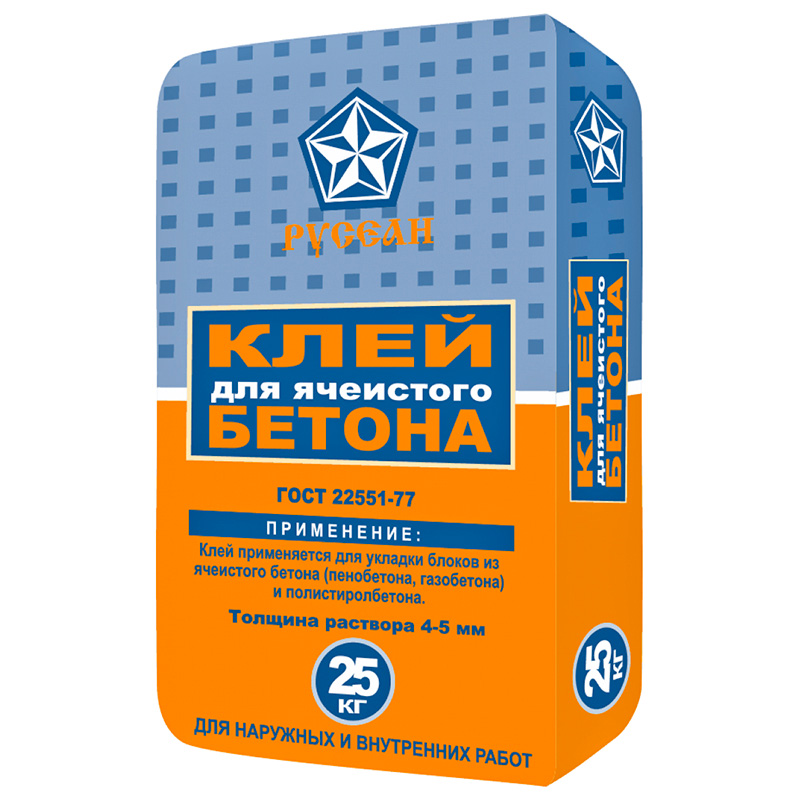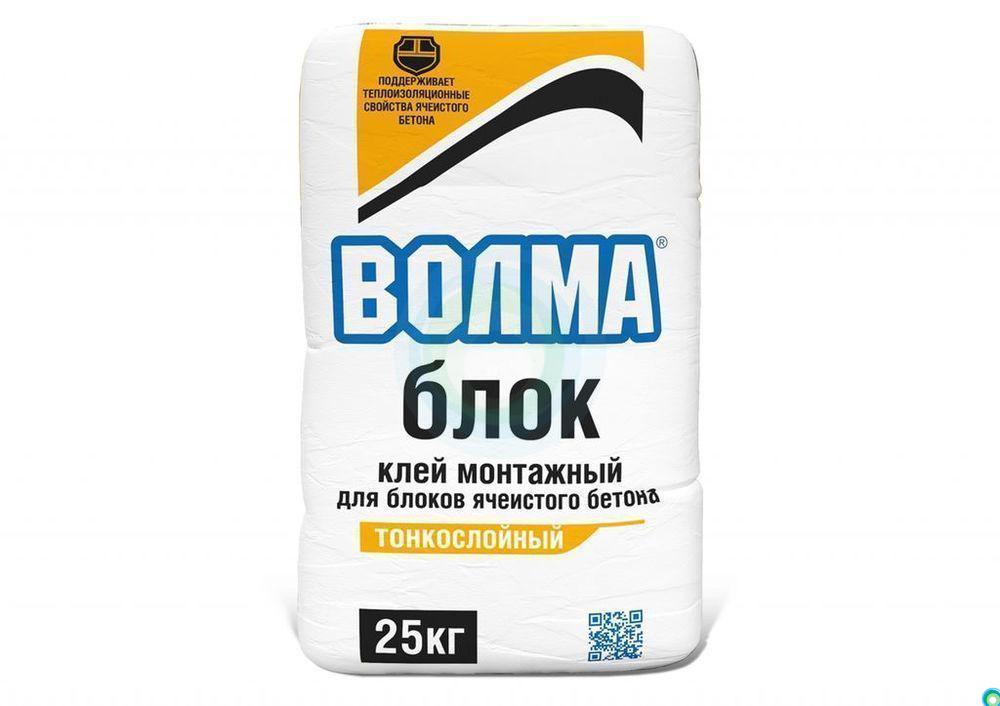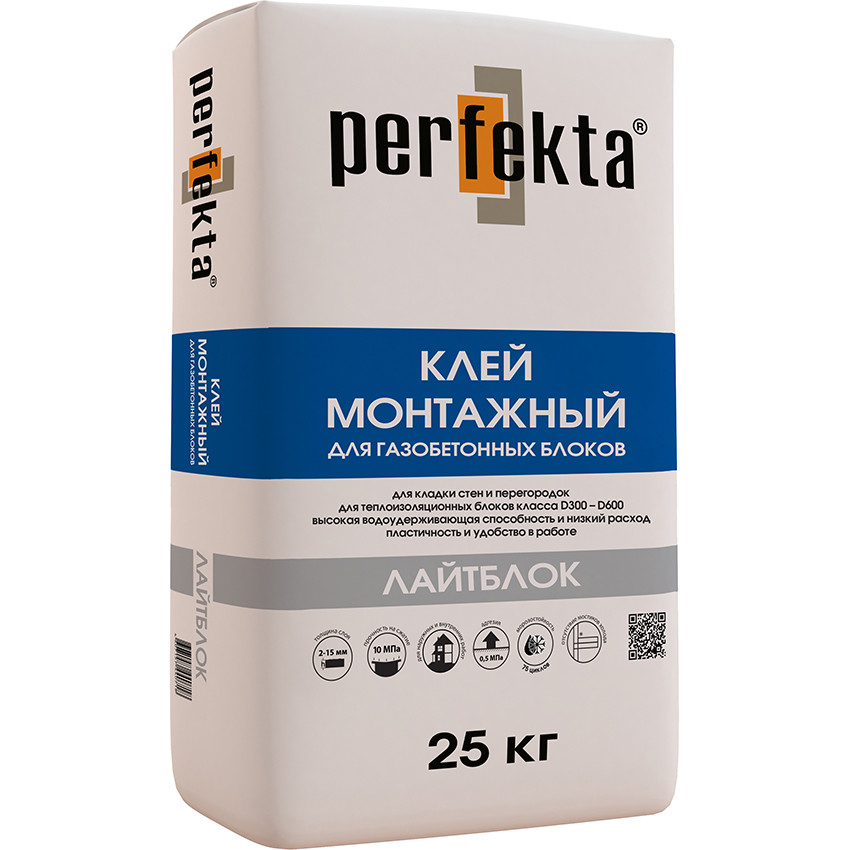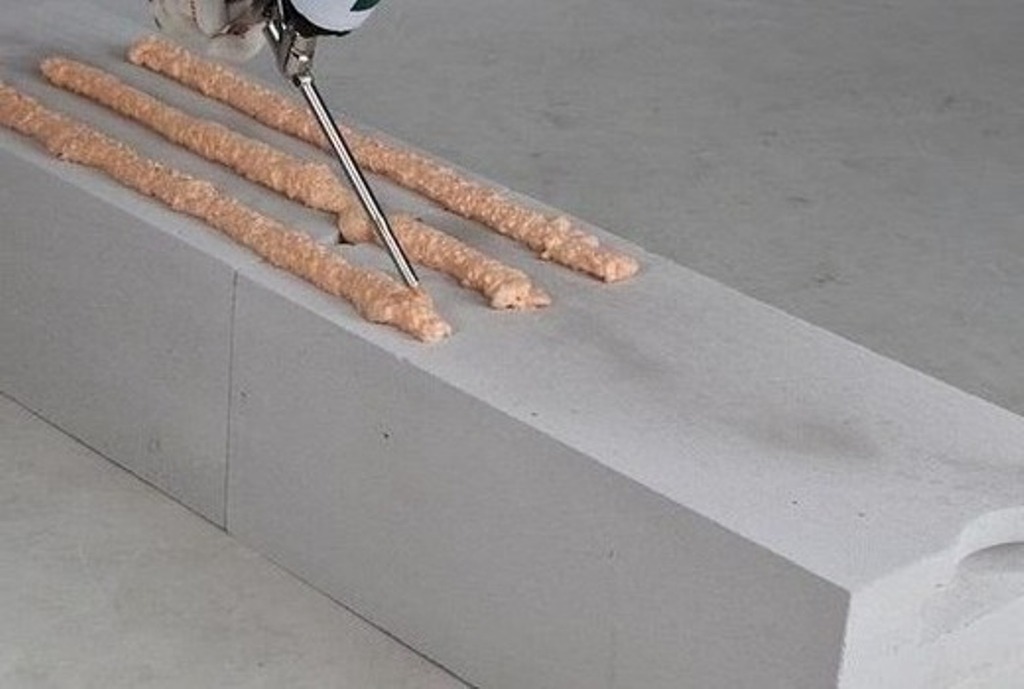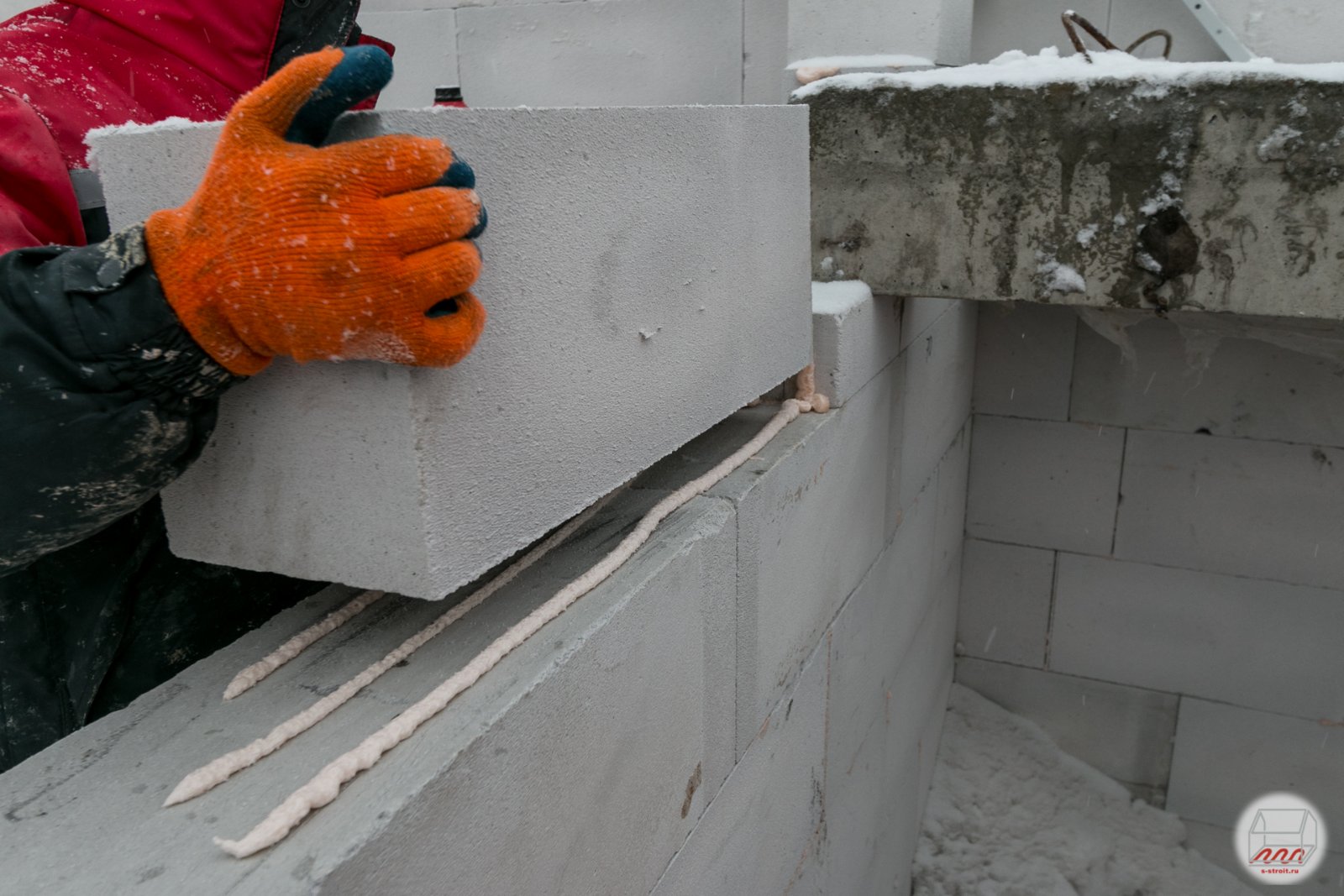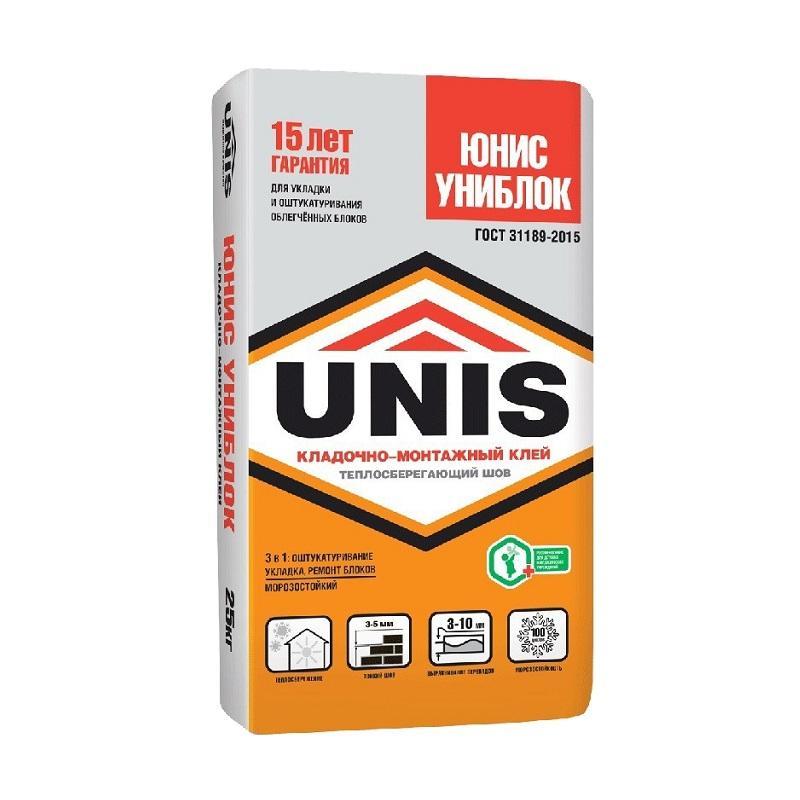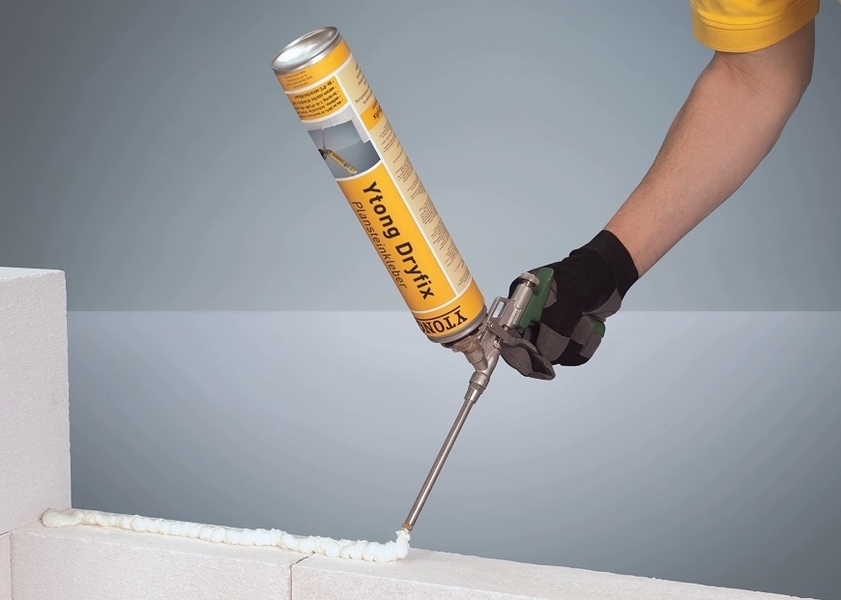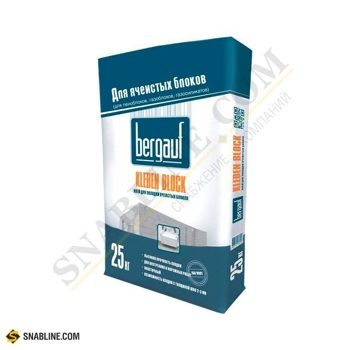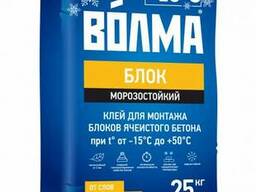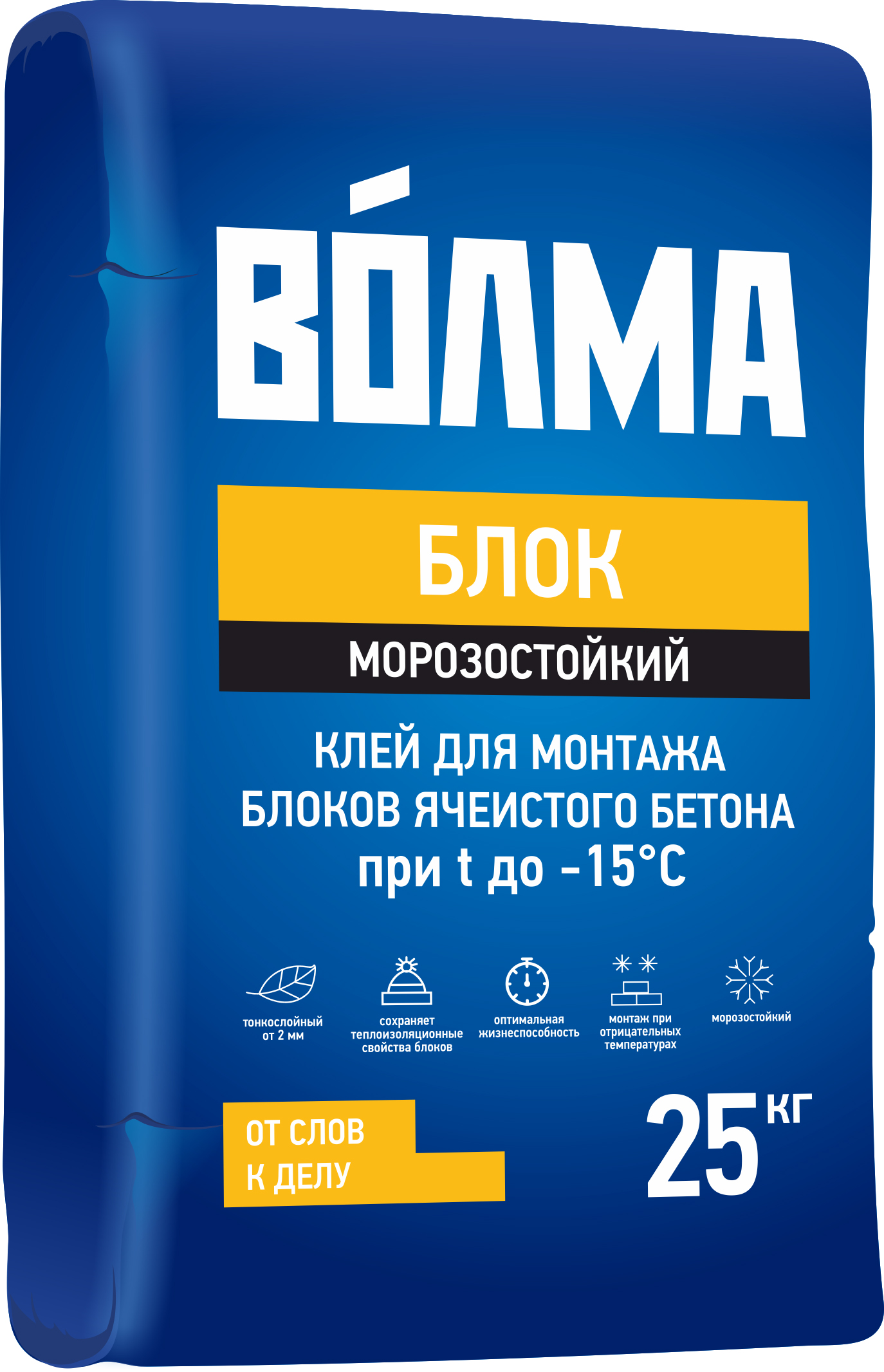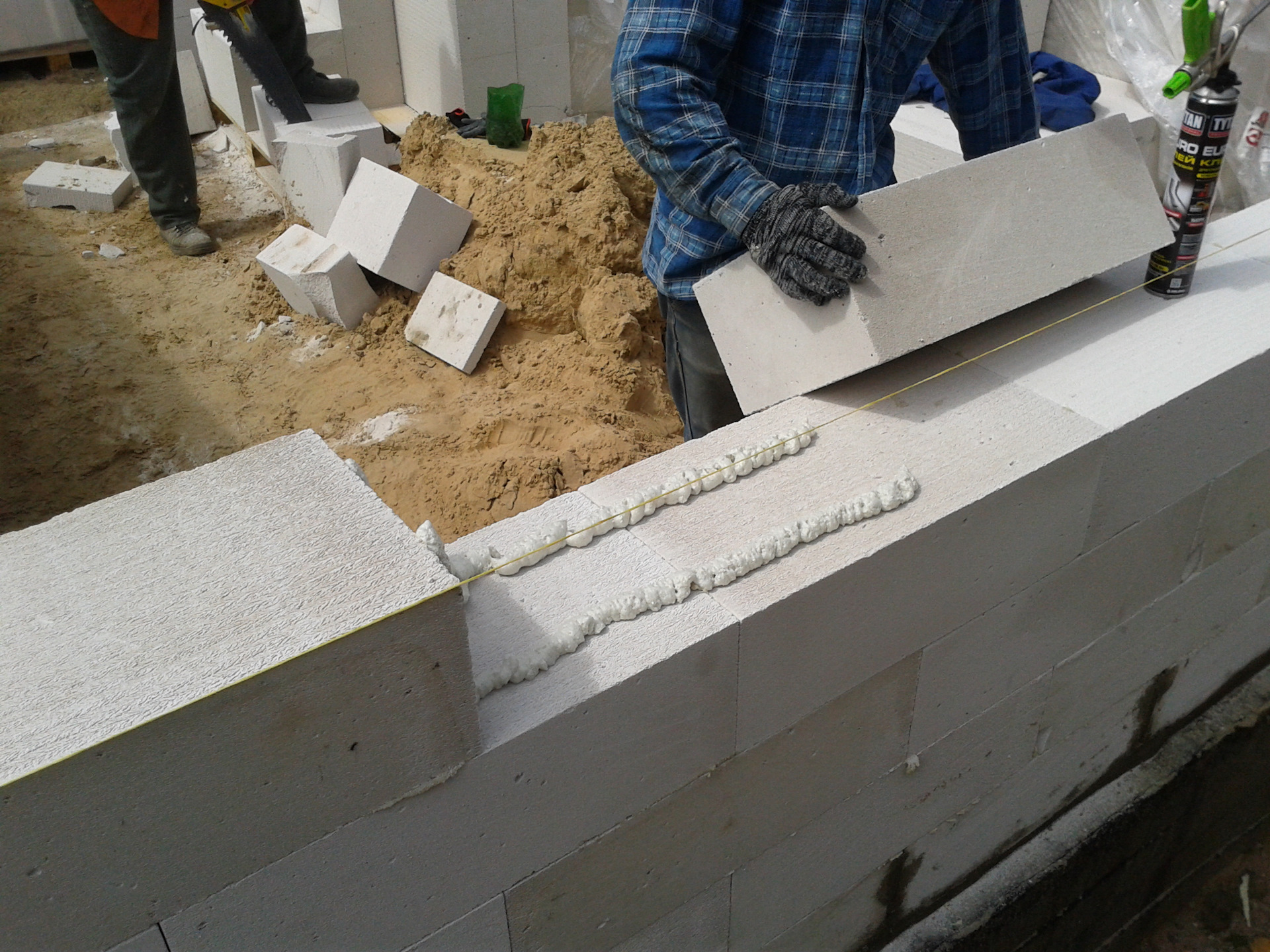Manufacturers overview
There is a wide variety of block adhesive products on the construction market. Work with ready-made solutions can be carried out indoors and outdoors. The composition does not include toxic substances that negatively affect human health. It is worth noting some of the most popular manufacturers of block adhesives:
- The German holding Henkel manufactures products under the Ceresit brand. Ceresit CT 21 masonry mixture is intended for gluing silicate and lightweight concrete blocks. For masonry at temperatures from 0 to +15 degrees, a type of product Ceresit CT 21 (Winter) is produced. Consumption per 1 cube of material depends on the size of the blocks and ranges from 16.5 to 20 kg with a layer of 2 mm.
- The Kolmix company supplies the Stroy Moment SMK-10 glue, intended for the construction of walls from structural elements. Average consumption of the product is 20 kg / m³. For installation at a temperature of -15 degrees, antifreeze additives are included in the solution.
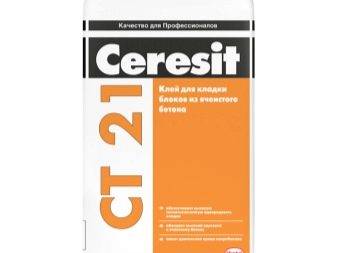
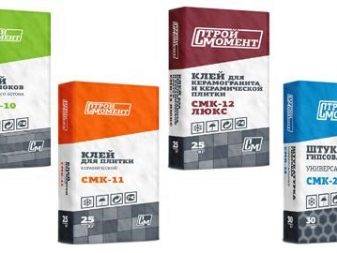
- For the laying of aerated concrete blocks, the "Block" mixtures from the "Volma" company are used. At a minimum consumption of 1.4 kg / m², it forms a thin seam of 1 mm.
- LLC "Prestige" produces an adhesive composition for foam and aerated concrete, which includes, in addition to the cement-sand mixture, imported additives. The solution has an increased pot life up to 3 hours. The optimum seam thickness is 5 mm. Shelf life is 6 months.
- The Kreps Corporation specializes in the supply of masonry mortars, including for block elements. Mortar "Kreps KGB" is suitable for use within 4 hours for laying a joint of 2-3 mm. When adding the "Kreps Antifreeze" additive, the solution can be used at temperatures up to -10 degrees.
- The Aerok SPb plant produces autoclaved aerated concrete and block glue. Two options for the composition of adhesive products allows installation work from -15 to +35 degrees. It is suitable for thin-coat applications up to 3 mm. Consumption for a two-millimeter layer is 15-19 kg / m³, depending on the thickness of the block.
- Good universal glue is produced by JSC Bonolit - Construction Solutions. It is suitable for applications from -10 to +25 degrees.
- The Unis group of companies has developed Uniblock masonry and assembly adhesive, which can be used for plastering, minor repairs and laying blocks based on concrete and silicate. It is suitable for leveling masonry differences up to 2 cm. With the help of "Uniblock" you can repair cracks and chips in the material.
- For laying gas silicate and foam concrete, Etalon Teplit glue, produced by Etalonstroy since 2004, is suitable. With a thickness of 1 mm, 1.4 kg / m² of mortar is consumed. The maximum seam is up to 6 mm. There are formulations for use in cold and warm seasons.
- The Belarusian plant of JSC “Zabudova” produces budget adhesive mixtures for laying blocks of aerated concrete of two varieties - winter No. 118.3 and summer No. 118.
- Blocks of gas silicate and expanded clay concrete can be joined with a mixture of CM 999.9, produced by LLC Formmaterialy. It forms a layer of 2–12 mm with a consumption of 1.8 kg / m².
What determines the difference in consumption figures
Even with experienced bricklayers, it happens that the actual costs of glue exceed the planned ones by 1.5-2 times. The difference in quantity arises from the nature of the construction.
The estimate, as close as possible to the reliable one, is possible taking into account the conditions affecting the masonry, these are:
- The ratio of the components that make up the mixture. If it contains an increased percentage of sand and various additives, the consumption increases. With a large percentage of adhesives, the declared consumption corresponds to the actual one.
- Technological process. Manufacturers' calculations are based on technology compliance.It is difficult for builders without sufficient experience to maintain the correct line when laying. For leveling, they increase the thickness of the joint for each block, using more glue.
- Reinforcement of layers in houses with 2 and higher floors. It will take more mortar to close the mesh that is placed between the blocks. Only then will the connection of gas silicate and other similar blocks to each other be strong.
- Construction products of poor quality, with surface defects. Overruns cannot be avoided - part of the adhesive goes into the pores, fills in chips and cracks. It is necessary to align the masonry seams, compensating for the irregular shapes of the material.
In addition, the conditions in which the construction takes place lead to an overconsumption of glue. Deviations from the optimum temperature and humidity in one direction or the other make adjustments.
The role of the tool used by the bricklayer is important. It is recommended to use a special bucket trowel, which ensures a uniform thickness of the seam and saves glue.
You can find out the average consumption declared by the manufacturer on the back of the package.
Manufacturers overview
There is a wide variety of block adhesive products on the construction market. Work with ready-made solutions can be carried out indoors and outdoors. The composition does not include toxic substances that negatively affect human health. It is worth noting some of the most popular manufacturers of block adhesives:
- The German holding Henkel manufactures products under the Ceresit brand. Ceresit CT 21 masonry mixture is intended for gluing silicate and lightweight concrete blocks. For masonry at temperatures from 0 to +15 degrees, a type of product Ceresit CT 21 (Winter) is produced. Consumption per 1 cube of material depends on the size of the blocks and ranges from 16.5 to 20 kg with a layer of 2 mm.
- The Kolmix company supplies the Stroy Moment SMK-10 glue, intended for the construction of walls from structural elements. Average consumption of the product is 20 kg / m³. For installation at a temperature of -15 degrees, antifreeze additives are included in the solution.
- For the laying of aerated concrete blocks, the "Block" mixtures from the "Volma" company are used. At a minimum consumption of 1.4 kg / m², it forms a thin seam of 1 mm.
- LLC "Prestige" produces an adhesive composition for foam and aerated concrete, which includes, in addition to the cement-sand mixture, imported additives. The solution has an increased pot life up to 3 hours. The optimum seam thickness is 5 mm. Shelf life is 6 months.
- The Kreps Corporation specializes in the supply of masonry mortars, including for block elements. Mortar "Kreps KGB" is suitable for use within 4 hours for laying a joint of 2-3 mm. When adding the "Kreps Antifreeze" additive, the solution can be used at temperatures up to -10 degrees.
- The Aerok SPb plant produces autoclaved aerated concrete and block glue. Two options for the composition of adhesive products allows installation work from -15 to +35 degrees. It is suitable for thin-coat applications up to 3 mm. Consumption for a two-millimeter layer is 15-19 kg / m³, depending on the thickness of the block.
- Good universal glue is produced by JSC Bonolit - Construction Solutions. It is suitable for applications from -10 to +25 degrees.
- The Unis group of companies has developed Uniblock masonry and assembly adhesive, which can be used for plastering, minor repairs and laying blocks based on concrete and silicate. It is suitable for leveling masonry differences up to 2 cm. With the help of "Uniblock" you can repair cracks and chips in the material.
- For laying gas silicate and foam concrete, Etalon Teplit glue, produced by Etalonstroy since 2004, is suitable. With a thickness of 1 mm, 1.4 kg / m² of mortar is consumed. The maximum seam is up to 6 mm. There are formulations for use in cold and warm seasons.
- The Belarusian plant of JSC “Zabudova” produces budget adhesive mixtures for laying blocks of aerated concrete of two varieties - winter No. 118.3 and summer No. 118.
- Blocks of gas silicate and expanded clay concrete can be joined with a mixture of CM 999.9, produced by LLC Formmaterialy. It forms a layer of 2–12 mm with a consumption of 1.8 kg / m².
- Among the polyurethane compounds, the Ytong Dryfix adhesive foam from the German company Xella stands out.
- The Polish manufacturer Selena produces Tytan Professional adhesive for ceramic blocks and aerated concrete.
- The construction foam "Macroflex" for bonding any building elements is produced by Henkel.
Polystyrene concrete laying technology using glue
Now it's time to study the progress of work directly. Let's figure out how to properly use the adhesive during masonry work, and what are the main features of the technology.
List of required tools
Let's start our overview with a list of the required tools.
To carry out the work you will need:
Building level,
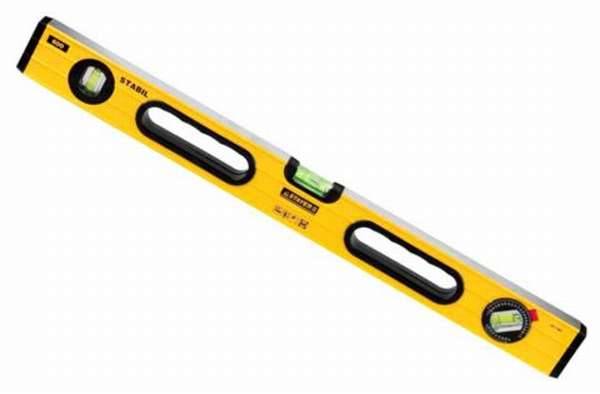
Rubber mallet,
Construction thread (cord),

Square,

Container for kneading the adhesive composition,
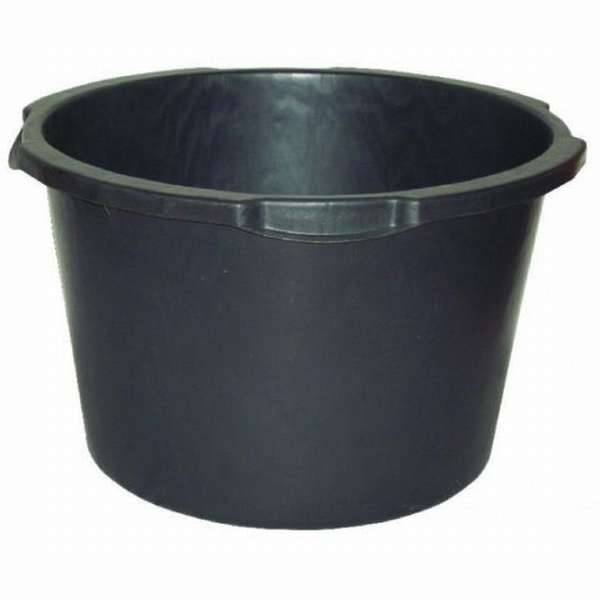
Drill with mixer,
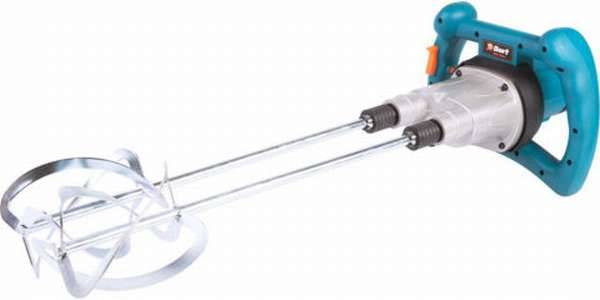
Scraper bucket,
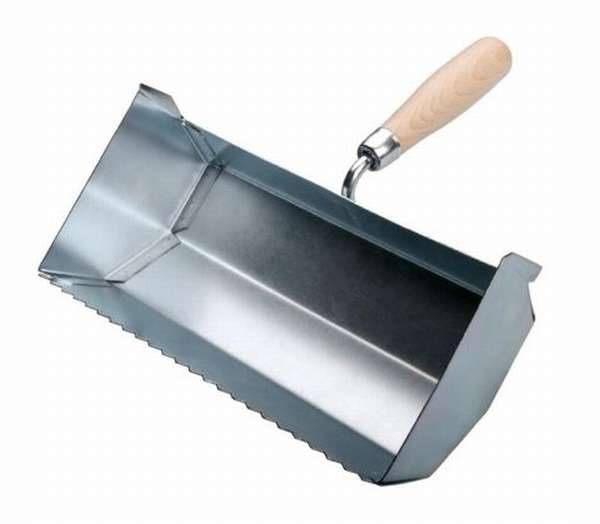
Grater,

Hacksaw,

Wall chaser.

Description of work progress
Stages of laying a block of polystyrene concrete: brief instructions:
|
|
First of all, it is necessary to waterproof the base. Roofing material is usually used, which is laid in two layers.
If there are flaws on the surface of the foundation, they are first eliminated with cement mortar. |
|
|
The beginning of the masonry work will be the installation of blocks in the corners of the future building. The starting point is the highest point, where the layer thickness will be minimal.
A cord is pulled between the products, which is an effective guideline when carrying out work. |
|
|
Despite the subsequent use of the glue mixture, the first row is laid using a self-prepared cement-sand mortar.
The above is relevant for all types of blocks, not just polystyrene concrete. In this case, the level of adhesion will be increased, and the strength of the structure will increase. |
|
|
After laying the first row, it is necessary to reinforce it.
In this case, a special mesh is used. |
|
|
Next, row by row are laid by analogy with a brick - with bandaging the seams. |
|
|
Dressing should be performed without fail.
The seam offset must be at least 20%. |
| Polystyrene concrete is easy to process.
If the size of the product does not correspond to the remaining gap, it is cut. In this case, the thickness of the seam should be taken into account. The photo shows a foam concrete block (as well as in some other photos), however, this is not of fundamental importance, since the cutting of polystyrene concrete occurs in the same way. |
|
|
|
Above, we have already talked about the time for adjusting the glue mixture, it is no more than 15 minutes.
In this regard, the check should be carried out as often as possible. Otherwise, it will no longer be possible to correct mistakes after setting. Due to the fact that the glue has a high peel strength, it is not possible to disassemble the wall, it is much easier to simply destroy it. |
| Lintels are installed in window and door openings. They can be made independently, but it is much more convenient to purchase them ready-made.
Moreover, a self-made version is allowed to be used only when installing especially narrow openings. |
|
| After completing the laying of the last row, upon reaching the desired height, a reinforcing belt is installed. It will not only increase the strength characteristics, but also increase the seismic resistance of the entire building as a whole. |
We glue expanded polystyrene
It's no secret that polystyrene concrete is used more often than others for insulating structures, since its thermal conductivity is very low, but the density values leave much to be desired. As a rule, they do not exceed the D600 grade.
Why? The thing is that it contains a crumb of polystyrene, and it has an excellent ability to store heat.
And since we are talking about this material, let's take a quick look at how to glue polystyrene foam to concrete.
This can be done in two ways:
- Using various types of glue,
- Application of dry construction mixture.
In the first case, it can be: bituminous glue, you can also use latex bitumen emulsion mastic, silicone glue or specialized polyurethane foam.
As for dry mixes, their choice is very large. They consist of a mixture of cement, polymer additives and a plasticizer.
How to stick polystyrene foam to concrete? The work process is quite simple. If glue is used, then, as a rule, it is applied around the entire perimeter and dotted over the entire surface. Sometimes a notched trowel is used to glue the entire board. After that, the expanded polystyrene product is pressed against the wall.

The finished mixture is applied in intermittent stripes over the entire surface, retreating from the edge about 2x-cm. If the irregularities on the wall are small, it is quite possible to use a notched trowel. Subsequently, the slab, as in the first case, is pressed against the wall.
The video in this article will tell you about the preparatory work before installing polystyrene foam.
Manufacturers
A wide range of adhesives for foam block masonry often confuses finishers. How to choose the right composition? How not to make a mistake when purchasing a mixture? What should the foam blocks be attached to?
First, remember a few simple rules:
avaricious pays twice - don't try to chase cheapness
buy goods from a well-known manufacturer with a good reputation in the building mixtures market
when making a purchase decision, take into account the season and temperature conditions under which the work will be carried out - it is advisable to purchase a frost-resistant composition for the winter
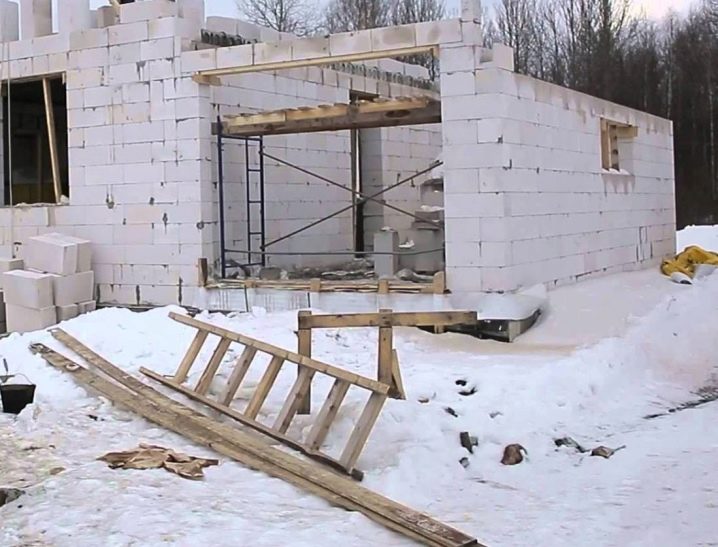
And now let's get acquainted with the creators of the most popular adhesives that have earned positive reviews from professionals around the world.
Volma
Volma is one of the leaders in the construction market, which has won the recognition of consumers in Russia and abroad. The adhesive of this brand consists of selected cement, fine sand, filler and pigments of the highest quality. This compound is used for joints of 2-5 mm.
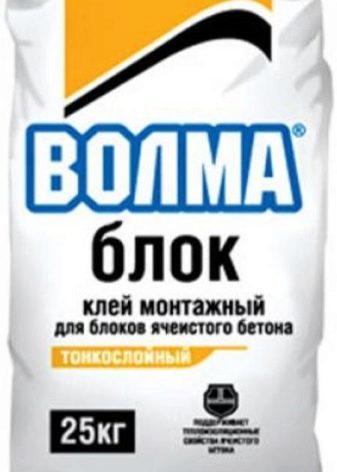
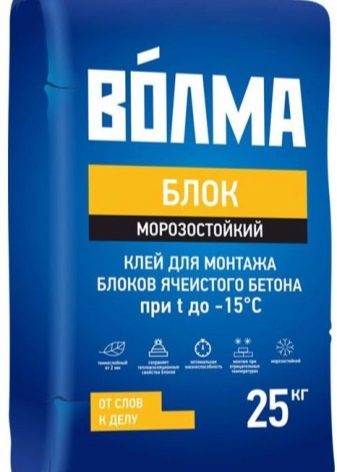
This glue is used by finishers when assembling slabs from aerated concrete blocks.
It is sold in 25 kg paper bags.
Titanium
When the glue-foam from the well-known brand "Titan" first appeared on the market, most professionals were skeptical about this new product. However, after the first applications, doubts about the quality and exceptional consumer indicators of the composition completely disappeared.
Titan products replace cement mortars, are very easy to use - you just need to apply a strip of composition to the blocks and fix them. At the same time, construction is progressing quite quickly, and the finished structure is durable and stable.

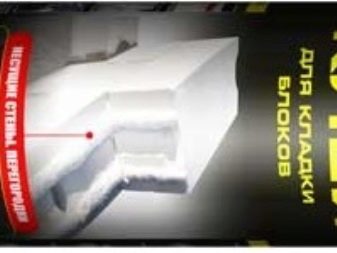
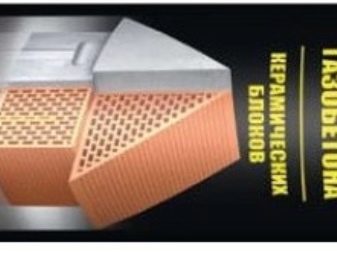
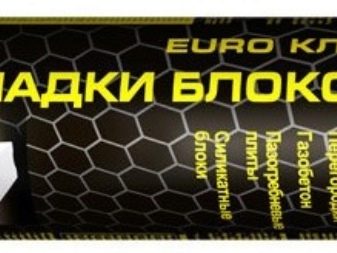
When applying foam glue, it is worth adhering to several rules:
- the surface of the foam blocks should only be flat;
- the layer of glue is applied in accordance with the instructions, do not exceed the thickness recommended by the manufacturer;
- the foam shrinks under the influence of direct ultraviolet rays, therefore, the joints should be sealed outside with cement;
- glue-foam is used only for the second layer of foam blocks. The first one should be applied to a cement-sand mortar, otherwise, under heavy weight, the glue will quickly deform.
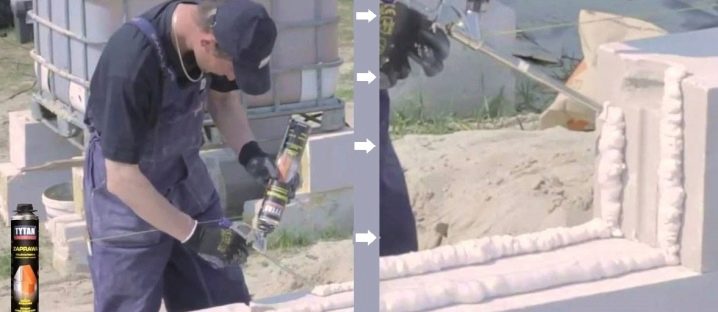
Available in 750 ml cylinders.
Knauf
Knauf Perlfix glue provides a high level of adhesion thanks to a plaster base and special polymer additives.
The use of glue does not require preliminary installation of the frame, the work is carried out quickly, and the structure is stable.
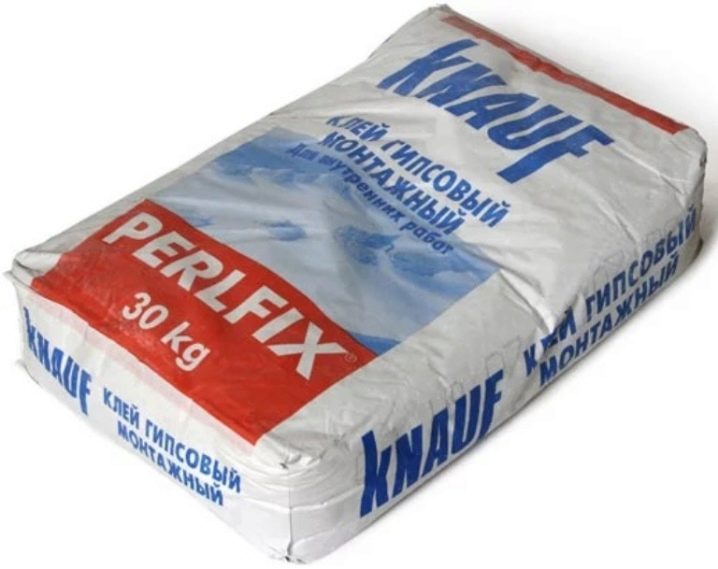
The undoubted advantage of the composition is its environmental safety, therefore it is widely used in private housing construction.
The glue is quite economically consumed - for processing a coating of 1 sq. m. only 5 kg of composition will be required.
It is sold in kraft bags with packaging of 30 kg.
IVSIL Block
The glue of this manufacturer has been widely used when laying aerated concrete and aerated concrete blocks. The mixture is a dry powdery composition based on cement with a small content of additives that increase the adhesion of the surface.
It is used for joints from 2 mm, with this glue consumption will be in the range of 3 kg per m2.
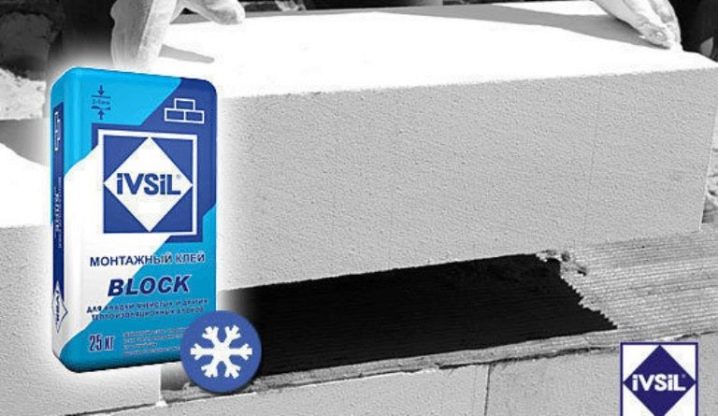
When using glue, the position of the foam blocks can be adjusted within 15 minutes from the moment of fixation.
It is sold in bags of 25 kg.
Osnovit Selform T112
It is a frost-resistant compound intended for use in winter. The formed joints can withstand up to 75 freeze-thaw cycles without any problems - this figure is one of the highest among winter types of foam concrete glue.
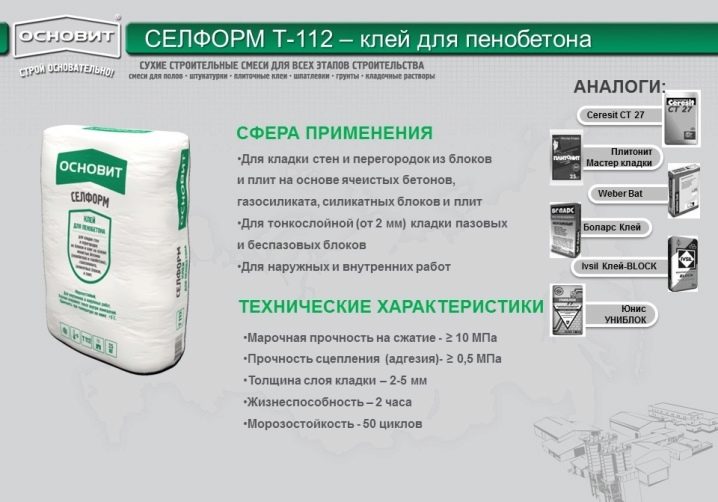
The adhesive mixture is characterized by a fine filler fraction, due to which it is used to obtain thin joints from 1 mm. This leads to a decrease in the total consumption of the composition - only 1.6 kg of dry glue is required for pasting 1 m2 of foam blocks.
The advantage of the glue is its quick adhesion - the composition hardens after 2 hours, so that construction work can be carried out quite quickly.
It is sold in bags of 20 kg.
Among Russian manufacturers, the Rusean brand is also distinguished as having high quality and cost-effective products.
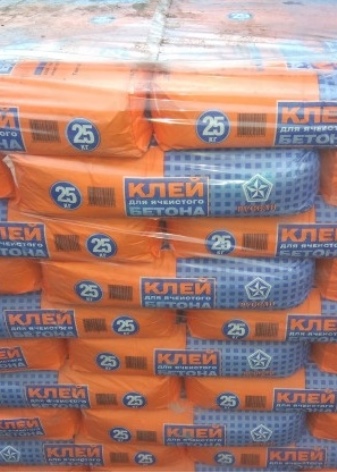
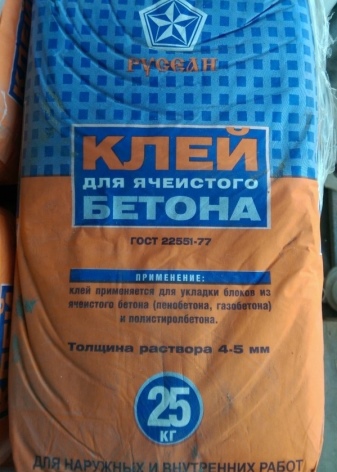
Material consumption dependence
The packages usually indicate how much glue goes to 1 cube of aerated concrete. When construction involves large volumes of work, the amount of material expended can significantly exceed the norms declared by the manufacturer. The difference can be very impressive in the consumption of glue for aerated concrete per 1 m3. But there are also the opposite situations. When calculating the required amount of the mixture, several factors must be taken into account:
- Properties of the composition of the glue. The more fractional impurities in the mixture, the higher the need for a large layer. If the composition is based on adhesives and adhesives, then a minimum layer (2-3 mm) can be dispensed with.
- Stacker qualification. The correct technique for using the bonding material greatly affects the consumption. Beginners often spend too much mortar on laying the gas block.
- The presence of a layer of reinforcement. If a reinforcing layer is provided in the gas-block wall, then the consumption of the mixture will greatly increase.
- Marriage of gas blocks. If you use a solution with a large amount of binders and the correct laying technique, and the gas block will have defects, then the consumption can increase significantly.
Masonry adhesive Kreps
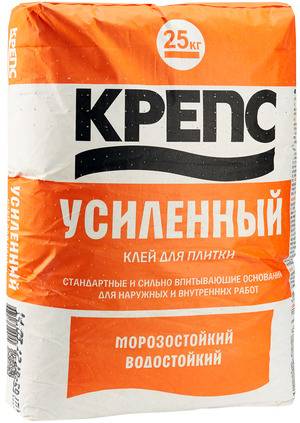
If all standards are observed, the average thickness of the adhesive layer is 2 mm. By using the minimum joint thickness, the risk of cracking can be minimized. One bag of dry mix is consumed for one cube of aerated concrete blocks.
You can count on spending not on volume, but on area. In this case, the consumption will be 1.5-1.6 kg per 1 m². Any physical impact is not terrible even with a thin layer of seams. Low temperatures and mechanical stress do not affect the final result.
Consumption of the mixture Insi-Block
This manufacturer produces not only ready-made mixtures for masonry, but also directly aerated concrete blocks. Mineral additives are added to the standard set of materials in the manufacture of glue. This makes it possible to increase the threshold for strength and adhesion. But it is possible to achieve high quality properties only if you apply the necessary layer provided by the manufacturer (thickness from 2 to 4 mm). Consumption of dry material - 28 kg per one cube of aerated concrete blocks.
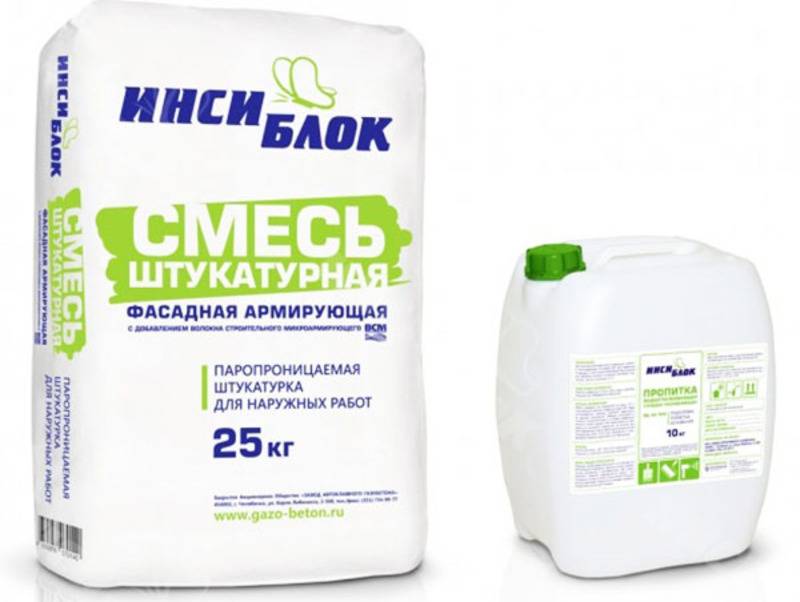
These costs were calculated on the basis of a layer of 2 mm. If the thickness of the seam is increased, then the expense, respectively, will be the same. This mixture comes on the market in bags of 25 kg, so, for example, for 10 cubic meters of blocks, you need to buy 11-12 bags of dry glue. One bag requires 5-5.5 liters of water.If you follow this proportion, then the ready-made solution can be used within three hours.
Masonry mix Real
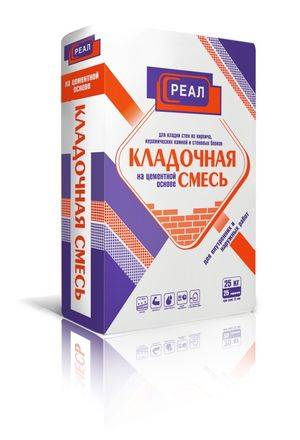
"Real" allows you to lay the gas block on a layer of 1 mm. With such a seam, the consumption per one cubic meter of the block is 21 kg of dry mixture. This glue is one of the most economical on the market at the moment. The quality of the masonry does not deteriorate because of this. It also allows you to save on plaster for wall cladding. The average layer thickness is reduced from 8 mm to 5 mm.
Assistance in choosing an adhesive
The question arises: what kind of glue is better to choose, and what should you pay attention to? This is what we are going to understand now.
Review of the most popular brands
The narrowly targeted adhesive for polystyrene concrete cannot boast of such a wide range as, for example, a composition for aerated concrete. However, there is still a choice. Moreover, there are universal compositions intended for lightweight concrete products in general, which can be easily applied in the case of laying a polystyrene concrete block.
As already mentioned, dry mixes of different brands differ from each other. Manufacturers strive to stand out from competitors, and for this purpose they focus on certain properties. In one solution there will be increased plasticity, in the other - its viability, and so on.
Let's use the table and consider some options for adhesive and masonry compositions in the form of dry mixes intended for laying polystyrene concrete.
Adhesives and masonry compounds from popular manufacturers:
|
|
It is a cement-sand mixture. However, this is not at all the solution that is obtained with self-preparation. This option contains special additives that regulate water permeability, atmospheric and biological stability.
The mixture is versatile, suitable for both outdoor and indoor use. Frost resistance grade - 200 cycles, correction time 10 minutes. The layer thickness can be from 2 to 8 mm. |
|
|
This composition is intended for laying most of lightweight concrete products and this should not surprise you. After all, all representatives of lightweight concrete are very similar to each other in terms of properties.
The composition differs in increased viability - up to 4 hours. But the adjustment time is only 5 minutes. Frost resistance reaches 200 cycles, peel strength is increased. The recommended layer thickness is 2-5 mm. |
|
Glue "Keraflex" |
Again, the adhesive is suitable for aerated concrete and polystyrene concrete block. He is universal. Frost resistance and durability are very competitive.
The pot life is about 3 hours, the time allotted for adjustment is 5-7 minutes. The manufacturer recommends using the glue at a temperature not lower than +5 degrees. The thickness of the seam should be from 2 mm to 1 cm. |
|
|
This is a variant of the winter composition, which we will discuss in more detail later.
The air temperature during work can be down to -10 degrees. The compressive strength is about 7.5 MPa, which is slightly higher than that of the above compositions. In most cases, the indicator for adhesive mixtures is 5 MPa. Frost resistance - about 50 cycles. Adjustment time 10 minutes. The layer thickness can be from 2 to 8 mm. |
|
|
This composition is suitable for laying almost any lightweight concrete product. He is also versatile.
Differs in moisture resistance, high peel strength. Compressive strength reaches 20 MPa. Pot life - 3 hours, product adjustment time - 7 minutes. |
Types of mixtures and their purpose
In total, there are two types of adhesive mixture: conventional compounds, the use of which is allowed at temperatures not lower than +5 degrees, and winter compounds, the use of which is permissible even at negative air temperatures.
Features of using glue with antifreeze additive are as follows:
- If the weather is warm outside, and you only have winter glue available, then it is quite possible to use it, and this will not entail any negative consequences. But the opposite is not worth doing.
- The presence of an antifreeze additive does not mean at all that styling can be done at absolutely any temperature. In severe frosts, work should be suspended. As a rule, manufacturers indicate a limit of minus 10-12 degrees. That is, these are the minimum temperatures.
- When using glue, the mixture is kneaded in small portions with the expectation that it will work out for about 20-30 minutes.
- It is recommended to use warm water.
- Block products should not be covered with snow or ice.
 A house from a polystyrene concrete block can be built in winter
A house from a polystyrene concrete block can be built in winter
By using these tips, you will be able to avoid unpleasant consequences.
Execution of works
Before proceeding with the laying of polystyrene concrete blocks, the base is waterproofed with roofing material. It is recommended to lay it in two layers. Flaws on the foundation surface are eliminated with cement mortar.
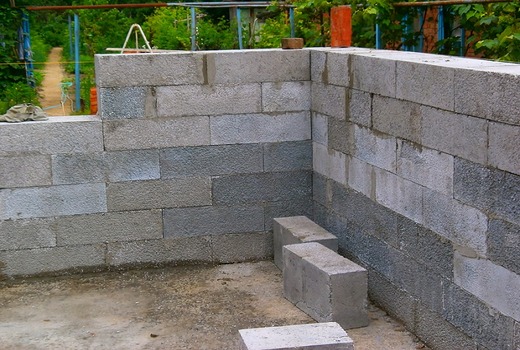
- The first blocks are installed in the corners of the building. A cord should be stretched between them, along which it will be easy to navigate during laying work.
- The first row is put on a mortar of cement with sand, which you prepared yourself. This method helps to improve the level of adhesion and strength indicators of the building. In subsequent rows, special glue will be applied.
- When the first row is laid out, it is reinforced with a special mesh.
- Then the next rows are laid with the obligatory reinforcement of the seams. At least 20% of the seams should be offset.
- To correct irregularities, no more than 15 minutes are allotted. For this reason, it is recommended to check more frequently. In the opposite case, it will be difficult to correct inaccuracies after the glue has set.
- Jumpers are mounted in the openings intended for windows and doors, which can be purchased ready-made or made by hand. Homemade options are permissible only when building too narrow openings.
- At the final stage of laying the last row, a reinforcing belt is mounted. This method will increase the strength of the structure and increase the seismic capacity of the entire building.
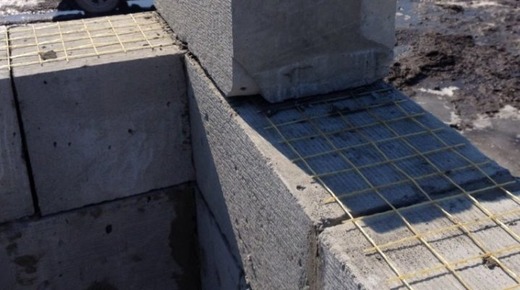
Differences between glue and cement mortar - the better it is
The technology for the correct laying of foam concrete differs from the methods of installing other wall materials, and cement mortar is poorly suited for its implementation. The thermal insulation properties of foam concrete blocks are higher than that of mortar, and thick layers of the latter make the structure blown and cold. When using this installation method, you will have to equip additional thermal insulation from the inside or outside of the wall.
The use of a special adhesive composition solves the problem. It forms a thin seam - durable, airtight and waterproof, so the room will be noticeably warmer. In addition, it is easier, faster to lay blocks on glue, it hardens more quickly, shortening the construction time. The cement mortar contains a lot of water, which immediately begins to be absorbed into the porous structure of the blocks, so you will also have to spend money on a water-repellent primer.
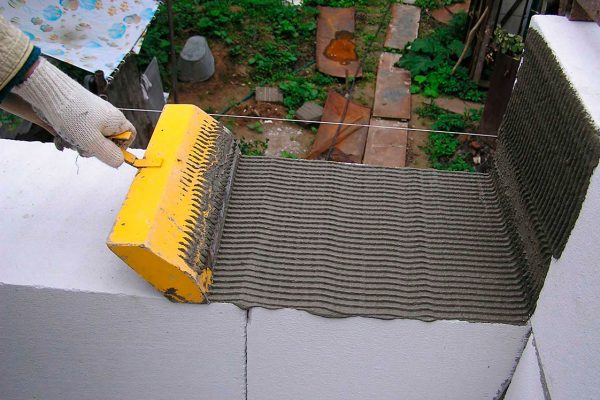
There are cases when it is still possible to lay blocks on a regular mortar:
- material size - about 30 cm;
- incorrect geometry of products;
- deviations in height - more than 1.5 cm;
- the presence of chips.
In other cases, it is better to purchase an adhesive composition, especially when the size of the foam blocks is up to 100 mm.
S-26 glue for porcelain stoneware
It is used for gluing porcelain stoneware tiles, marble, composite stone on various surfaces. Consumption 1.5 - 1.6 kg. dry mix for 1 m² with a layer of 1 mm.
All those characteristics that porcelain stoneware possesses can be realized only with its correct installation.
Conversely, if the installation of porcelain stoneware is done with errors or incorrectly, then the tiles will begin to lag behind the surface and collapse with minimal impact on it.
An important, if not the main, role for obtaining a good result from the use of tiles is played by the used glue C-26 for porcelain stoneware.
- Water and frost resistant
- Highly adhesive
- Elastic
- Reinforced fixation
- Has increased durability
- For interior and exterior use
|
Composition S-26 |
A mixture of cement with mineral fillers and polymer modifiers |
|
Bulk density of dry mix |
1.50 ± 0.1 kg / dm3 |
|
Mixing water amount |
about 7.0 liters per 25 kg. dry mix |
|
Density of the mixture ready to use |
1.8 ± 0.1kg / dm3 |
|
Consumption time |
at least 2 hours |
|
Application temperature |
From +5 to + 30 ° C |
|
Open time |
At least 25 minutes |
|
Adjustment time |
At least 10 minutes |
|
Adhesion to concrete at the age of 28 days |
Not less than 0.8 MPa |
|
Sliding tiles |
no more than 0.5 mm |
|
Dry mix consumption |
about 6.0 kg / m2 with a layer thickness of 3 mm |
Application area
It is used for gluing porcelain stoneware tiles, marble, composite stone on various surfaces.
It is applied on concrete, stone surfaces, bricks, plasters, gypsum boards, drywall. Possesses high adhesion and increased strength. For interior and exterior use.
Surface preparation
The base for the cladding must be strong, not subject to shrinkage or deformation, free from dirt, dust, oils, grease and all types of paints, as well as flaking elements. Cement-based surfaces with high water absorption must be moistened before gluing.
Mortar preparation and application
To prepare the mortar mixture, an accurately measured amount of pure water is taken. The dry mixture is gradually added to water with stirring, achieving a homogeneous mass without lumps. Mixing is carried out using a mixer or a drill with a nozzle for viscous mortar mixtures at a rotation speed of 400-800 rpm. Then maintain a technological pause for 5 minutes to ripen the mortar mixture and mix again. The mortar mixture should be consumed within 2 hours.
Shelf life
12 months.
The product is certified, passed the sanitary and epidemiological examination.
Products comply with GOST 31357-2007, GOST 28013 -98
Review of popular adhesives
Modern manufacturers offer a large selection of assembly adhesives for aerated concrete. You need to choose according to requirements and properties, trusting the best brands that guarantee high quality products and compliance with the declared parameters.
Hercules
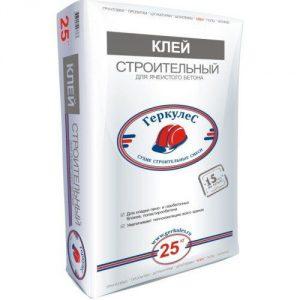
The glue is used for laying cellular concrete and is supplied dry in a sealed container weighing 25 kilograms. Suitable for construction inside and outside the building, as well as for leveling out minimum defects with a maximum size of 10 millimeters.
The composition of the glue includes: cement, sand, various powder polymers, complete absence of harmful toxic compounds. The assembly adhesive demonstrates a high level of strength, guarantees reliable masonry, good thermal insulation. A hard seam is not afraid of precipitation, minus, moisture.
Rusean
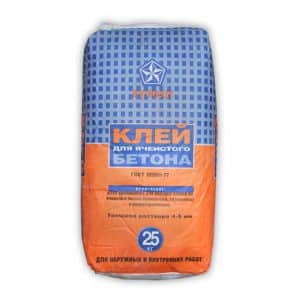
Mounting adhesive is designed for indoor and outdoor use, guarantees a quick connection of any porous materials. The composition includes cement M500, quartz sand, various types of mineral additives. The mixture turns out to be plastic, with good adhesion, the seam withstands exposure to moisture, low and high temperatures.
Volma block
The mixture is created from cement, fractional sand, high-quality additives. The composition is elastic, dense and durable. It is applied in a thin layer, which increases the thermal insulation characteristics of the masonry. Not afraid of low temperatures, suitable for all types of aerated concrete.
Composition for masonry blocks from aerated concrete K21 / 1
This type of masonry compound is a dry mortar made of cement, quartz sand, polymers and minerals. It is diluted with water, forms a plastic mixture with good adhesion characteristics, after hardening, it calmly withstands a large minus and exposure to moisture.
The glue is used for laying aerated concrete blocks with a clear shape and size, since the seam thickness is 2-3 millimeters. The mixture can be used for the installation of expanded clay concrete blocks, other materials, it is ideal for eliminating small defects on the surface inside and outside the building.
Mounting adhesive has all the advantages of this type of compound.
The dry mixture is diluted with water in a ratio of 4.5: 1, mixed at low speed with a stirrer, settled for 10 minutes, then mixed again and used for a maximum of 2 hours. It is applied with a notched trowel on the surface at a temperature of + 5-25C, on a solid and even, always clean, slightly damp base.
Blocks are adjusted quickly, with a hammer within 5 minutes after laying. Excess mortar is removed with a trowel, the thickness of the seam should be a maximum of 3 millimeters. The consumption of the mixture is approximately 25 kilograms per 1m3 of blocks. Installation is best done in dry conditions, at a temperature of + 5-25C, the final hardening occurs within a day.
Instead of a conclusion:
Mounting adhesive for aerated concrete today is considered the most preferred option when choosing a mortar for masonry. Simple preparation, minimal joint thickness, easy and fast work, high quality of the joint, increased thermal insulation properties and a host of other advantages fully justify the cost of the mixture and make it an ideal choice for high-quality modern construction.
Glue mixture solution preparation technology
The preparation of the working solution is carried out according to the instructions of the manufacturer of the dry concentrate. The general steps and principles for preparing an adhesive mixture include the following points:
- to prepare the solution, use a container of the appropriate volume and a drill with a mixer;
- measure the required amount of dry mix and water as indicated in the manufacturer's instructions. As a rule, the proportions are on average 1: 0.22, that is, 220 g of water is taken for 1 kg of dry concentrate;
- the range of water temperature for the solution is from +15 to + 60 ° C;
- knead the mass until smooth, then let the solution settle for 10-15 minutes and mix thoroughly again.
The solution is mixed in portions in accordance with the intensity of work on laying aerated concrete. The service life of the working mixture is about 3-4 hours, but this figure may vary depending on the brand, working conditions and other design factors. It is not allowed to add water to the finished solution, while the glue should be periodically stirred during operation.
It should be borne in mind that the consumption of glue for gas silicate depends on a number of factors, including:
- block geometry and surface defects;
- the presence of reinforcing elements;
- characteristics of the tool for applying the bonding agent;
- temperature and concentration of the solution;
- weather conditions and qualifications of the master.
The formula for the consumption of the adhesive solution looks like this: S = [(l + h) / l * h] * b 1.4, where:
- S - consumption of 1 kg of the mixture per 1 m³ of the base;
- l, h - dimensions of length and height in m;
- b - seam thickness in mm;
- 1.4 - conventional value of the consumption of dry concentrate in kg / m² with a thickness of the bonding layer of 1 mm.
In order to carry out the construction of walls made of porous concrete with the highest quality, it is necessary to use adhesive mixtures taking into account their purpose: for indoor or outdoor work, for laying gas silicate at positive or negative ambient temperatures
It is also worth paying attention to the setting speed of the working solution, this parameter varies from 5 to 25 minutes, depending on the brand of product
In this case, the minimum period of solidification of the adhesive base in a block structure is 24 hours, and for the final result, a period of at least three days is required after installation.

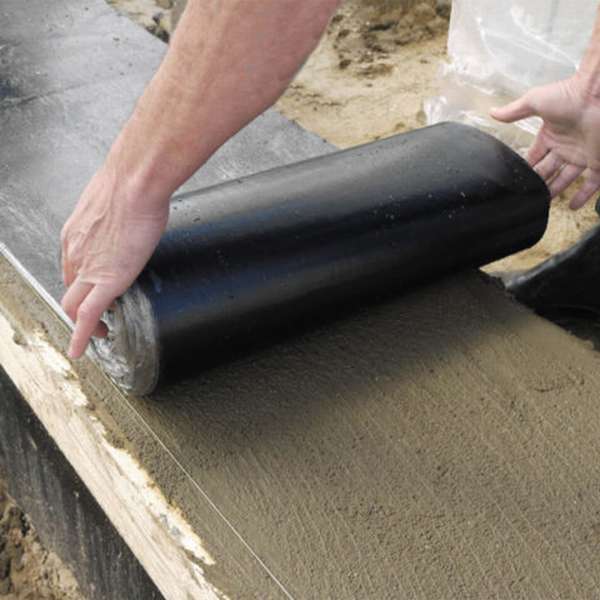

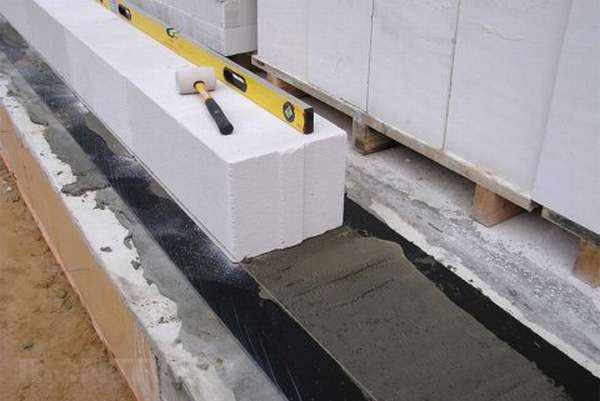
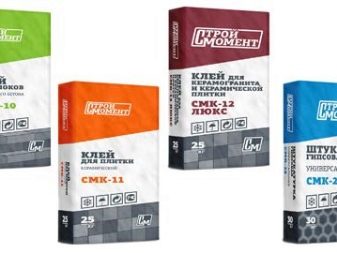
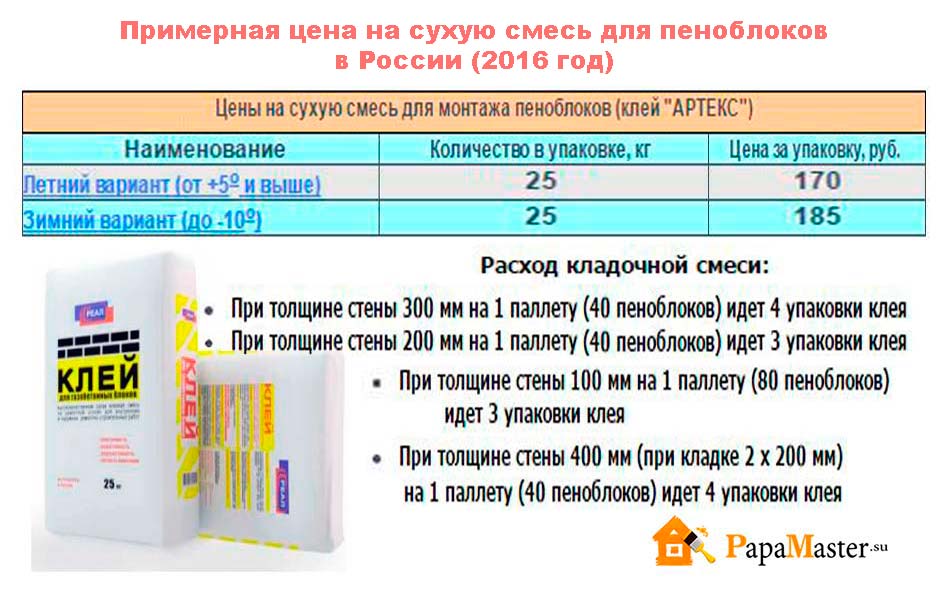
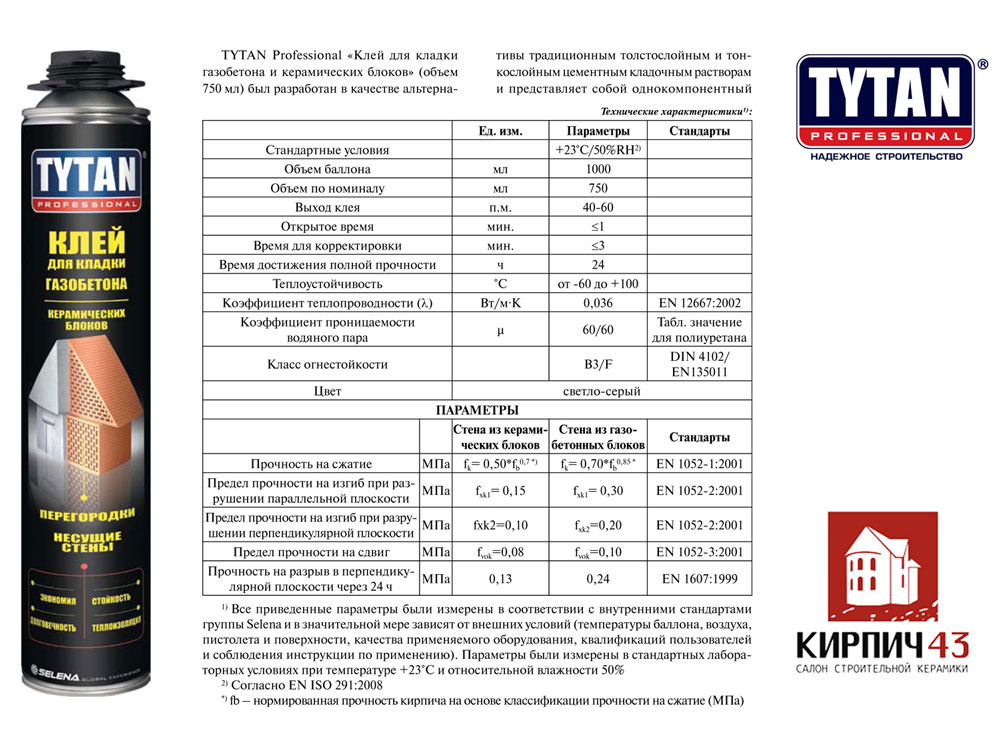
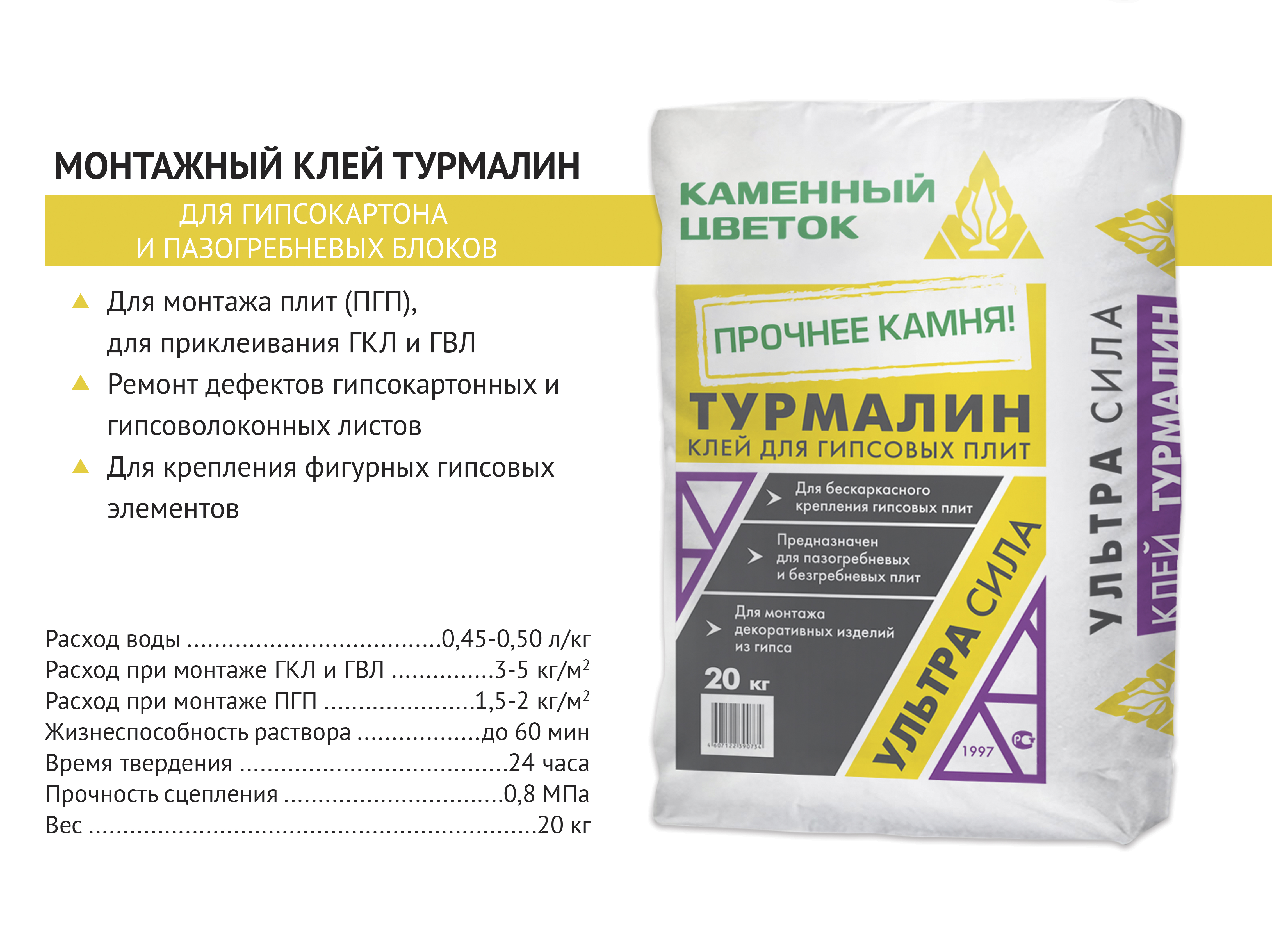
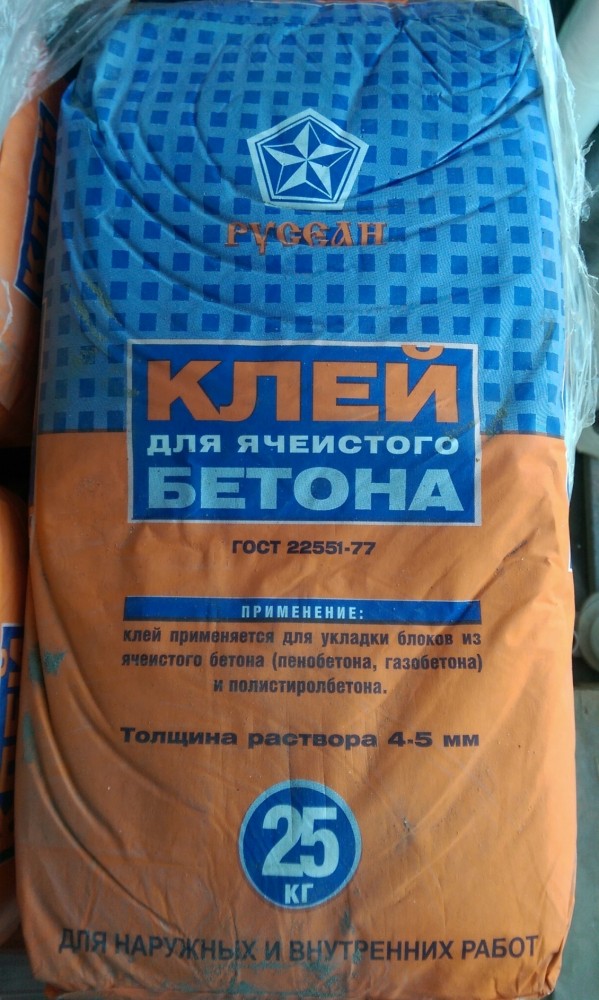

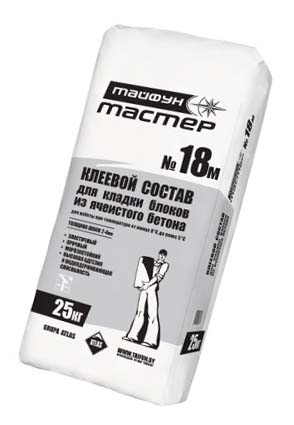
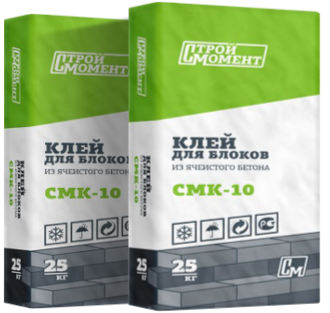
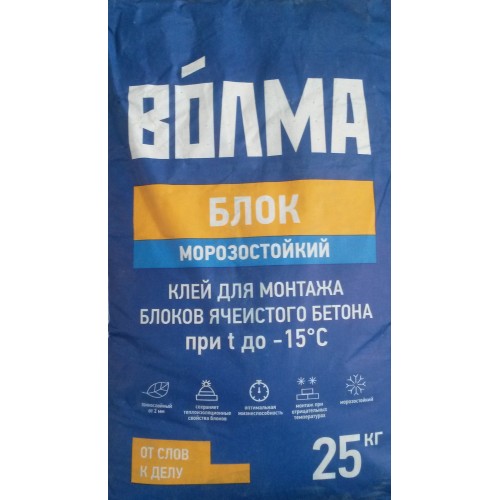
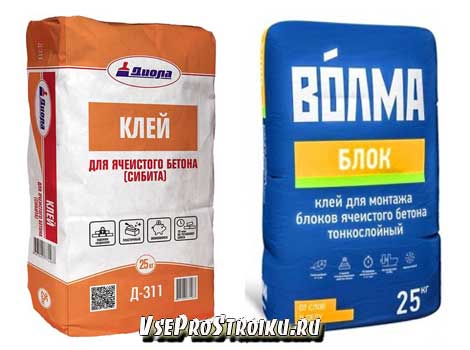

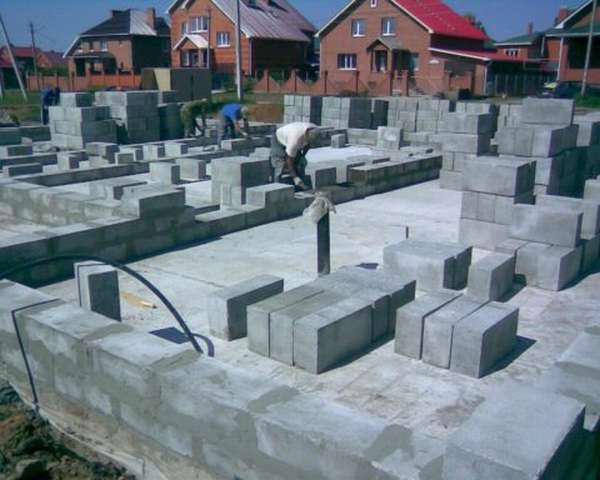

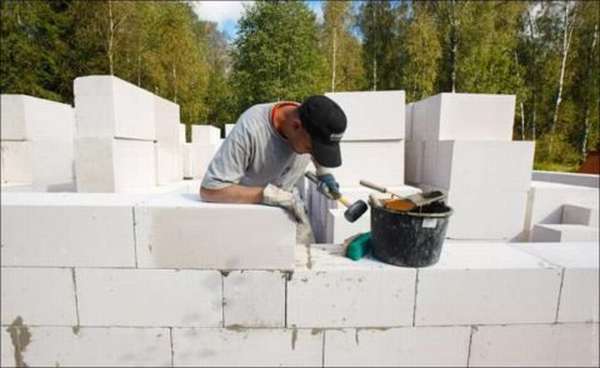
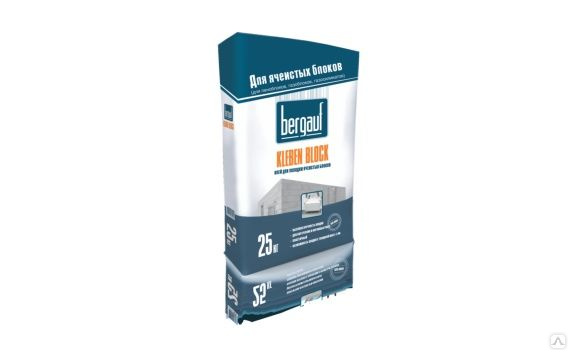
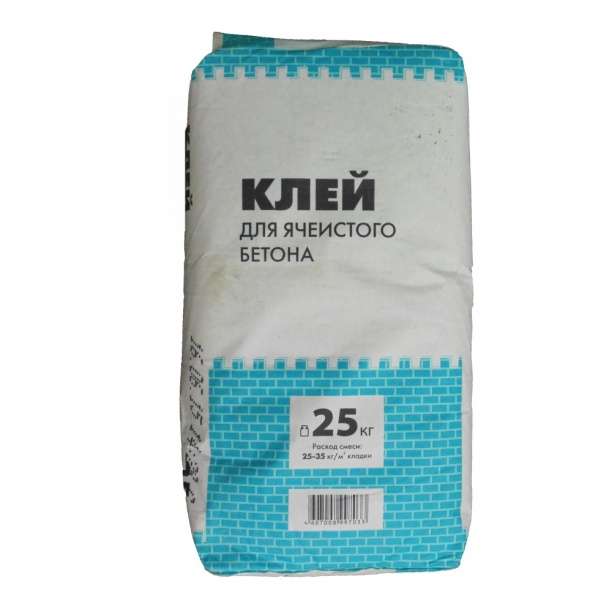

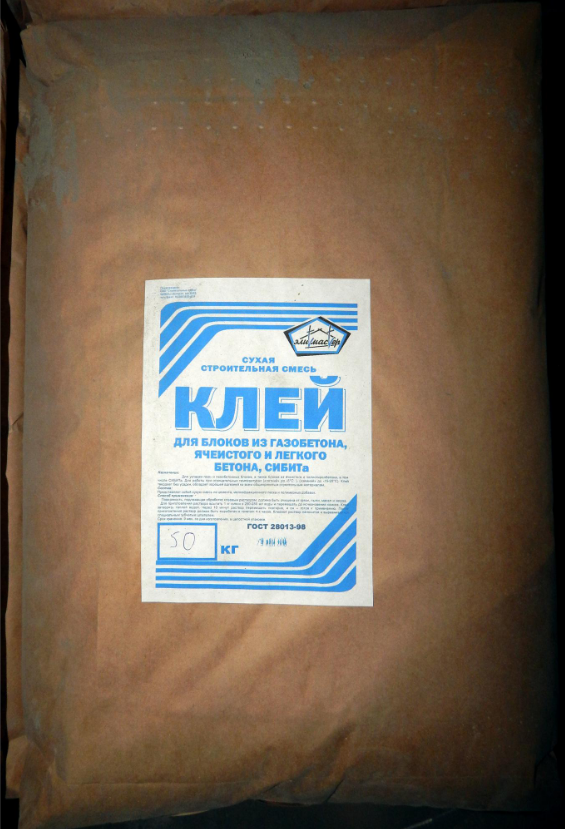
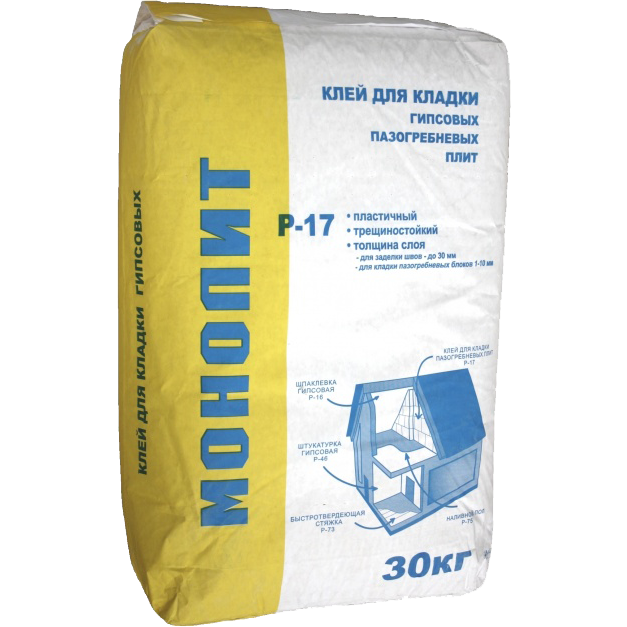

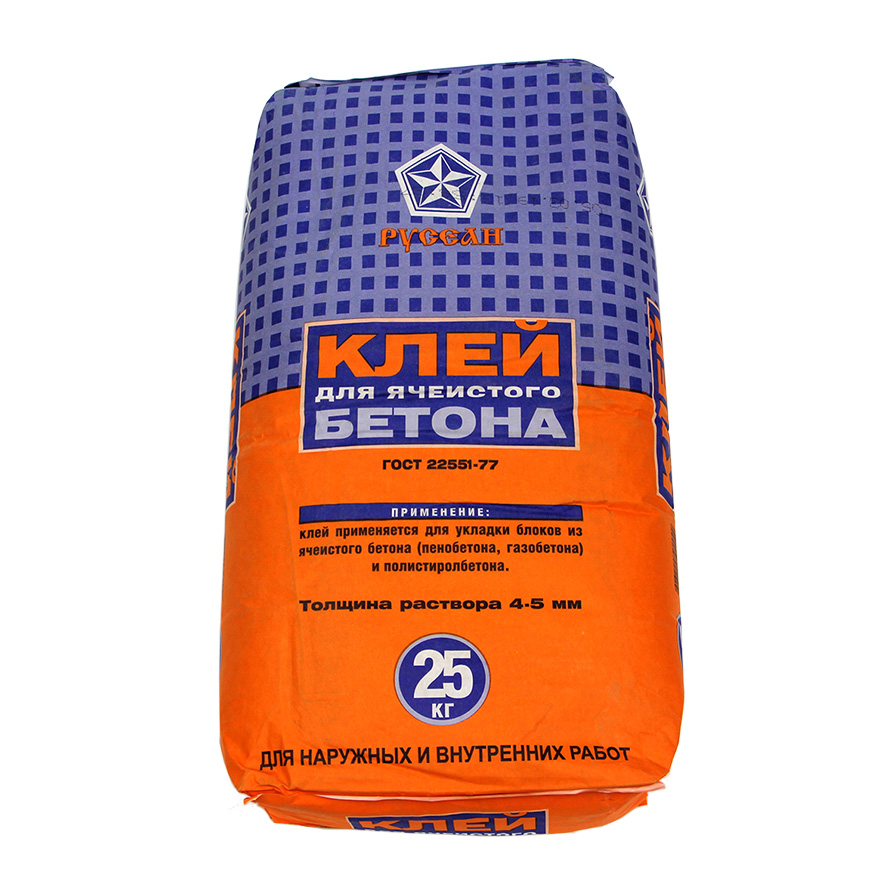
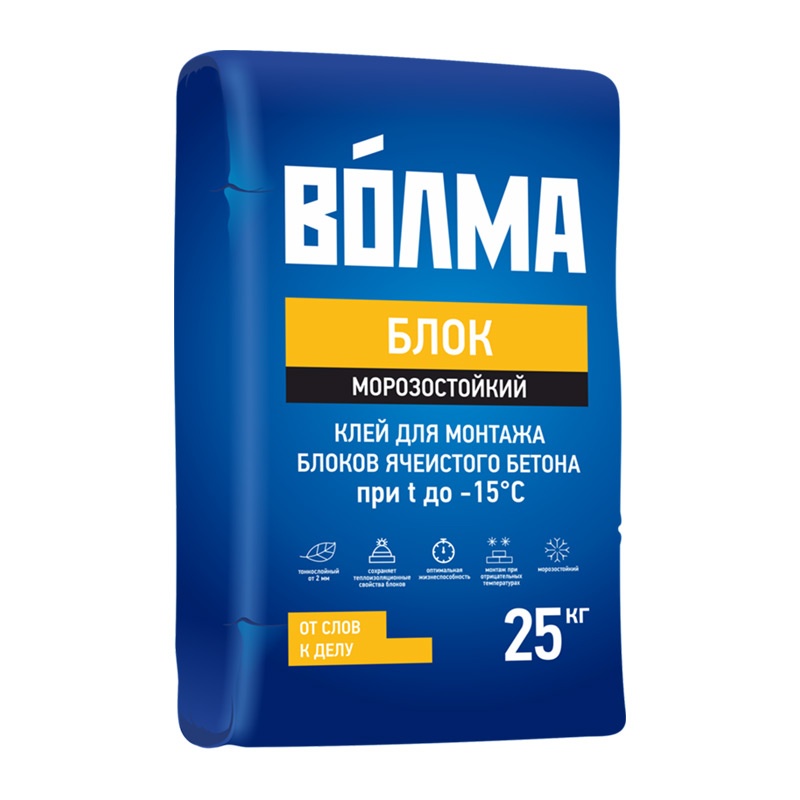
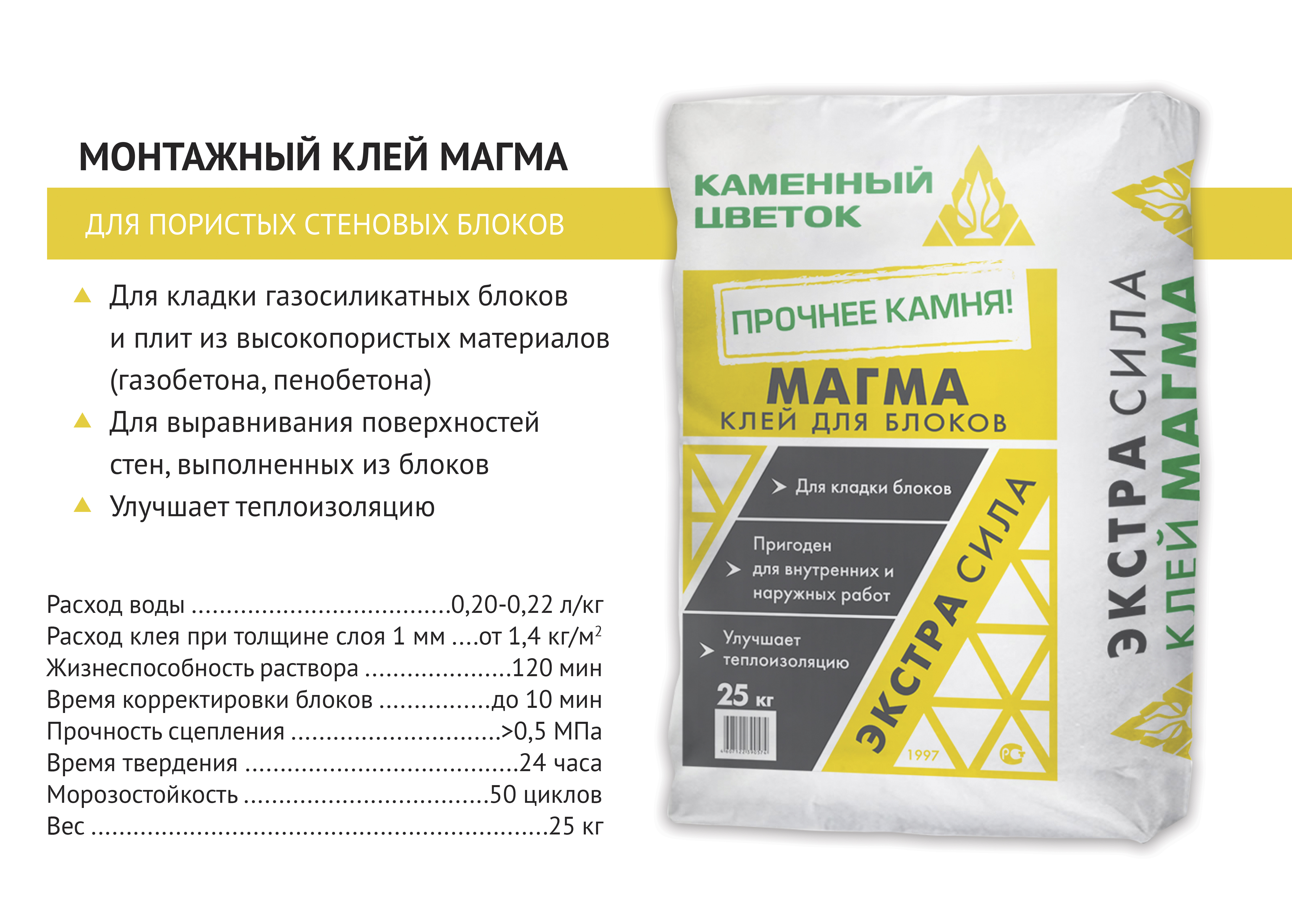

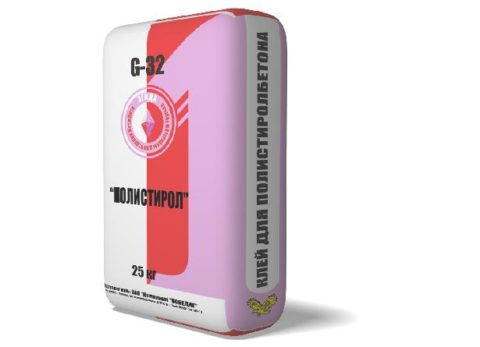 Composition for laying polystyrene concrete block "Polystyrene"
Composition for laying polystyrene concrete block "Polystyrene"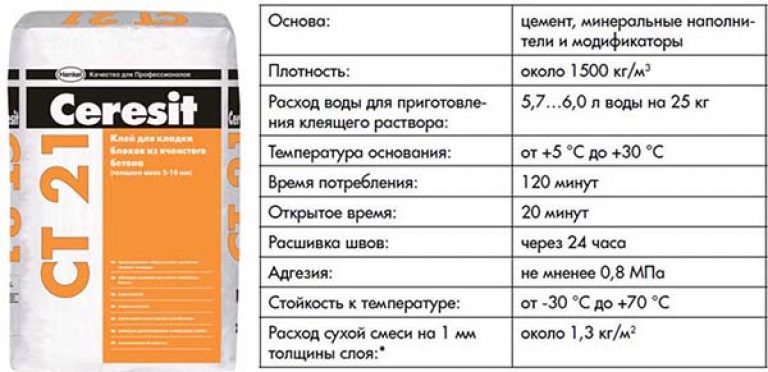
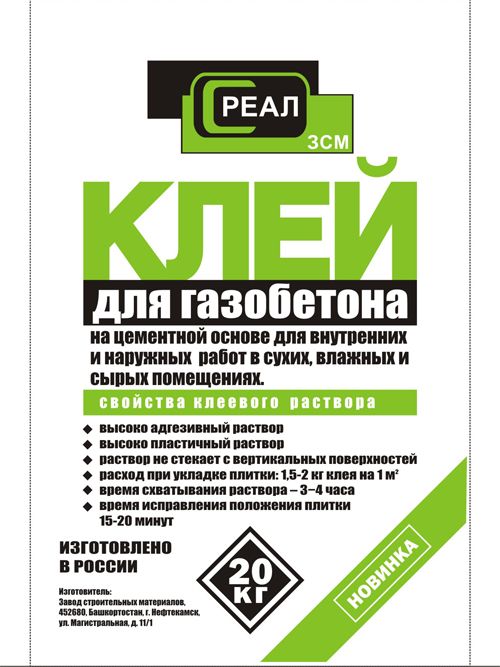
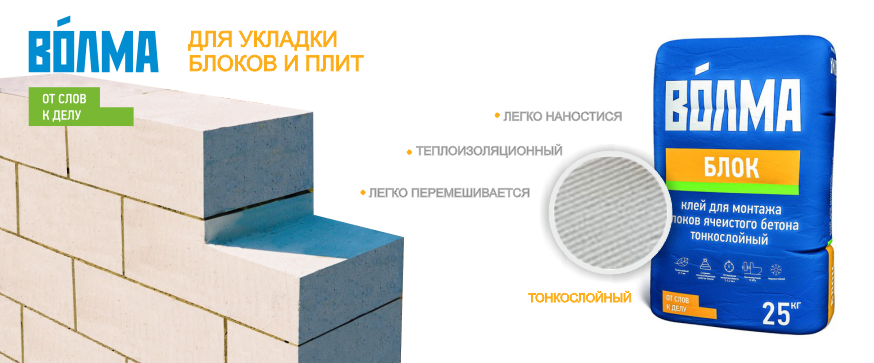
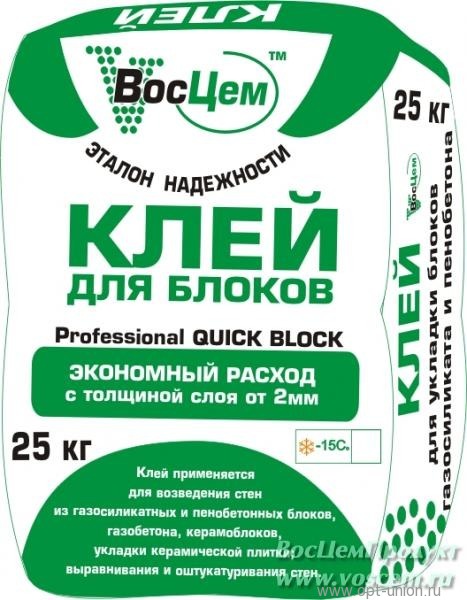

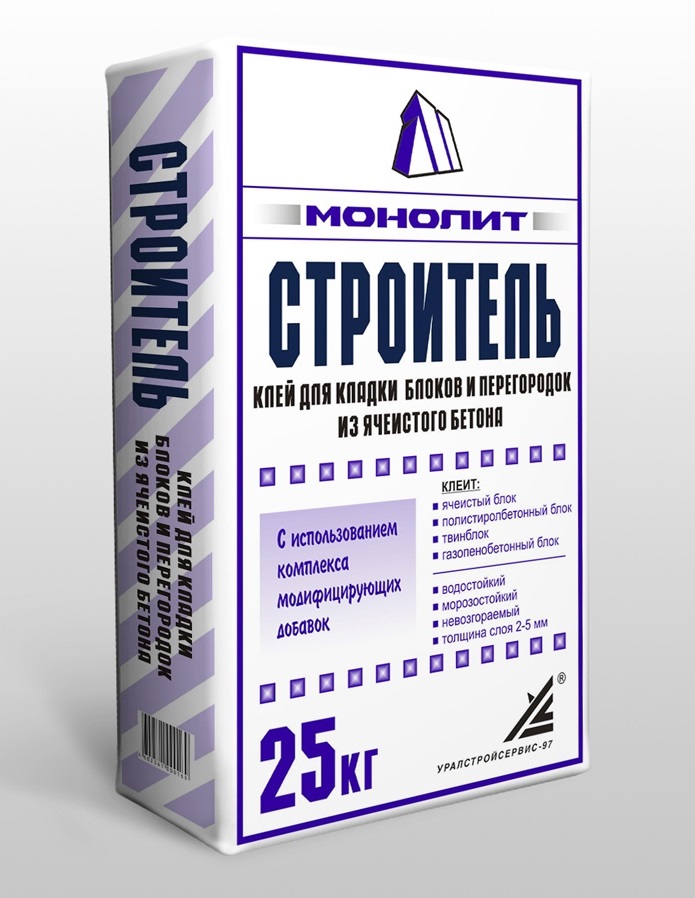

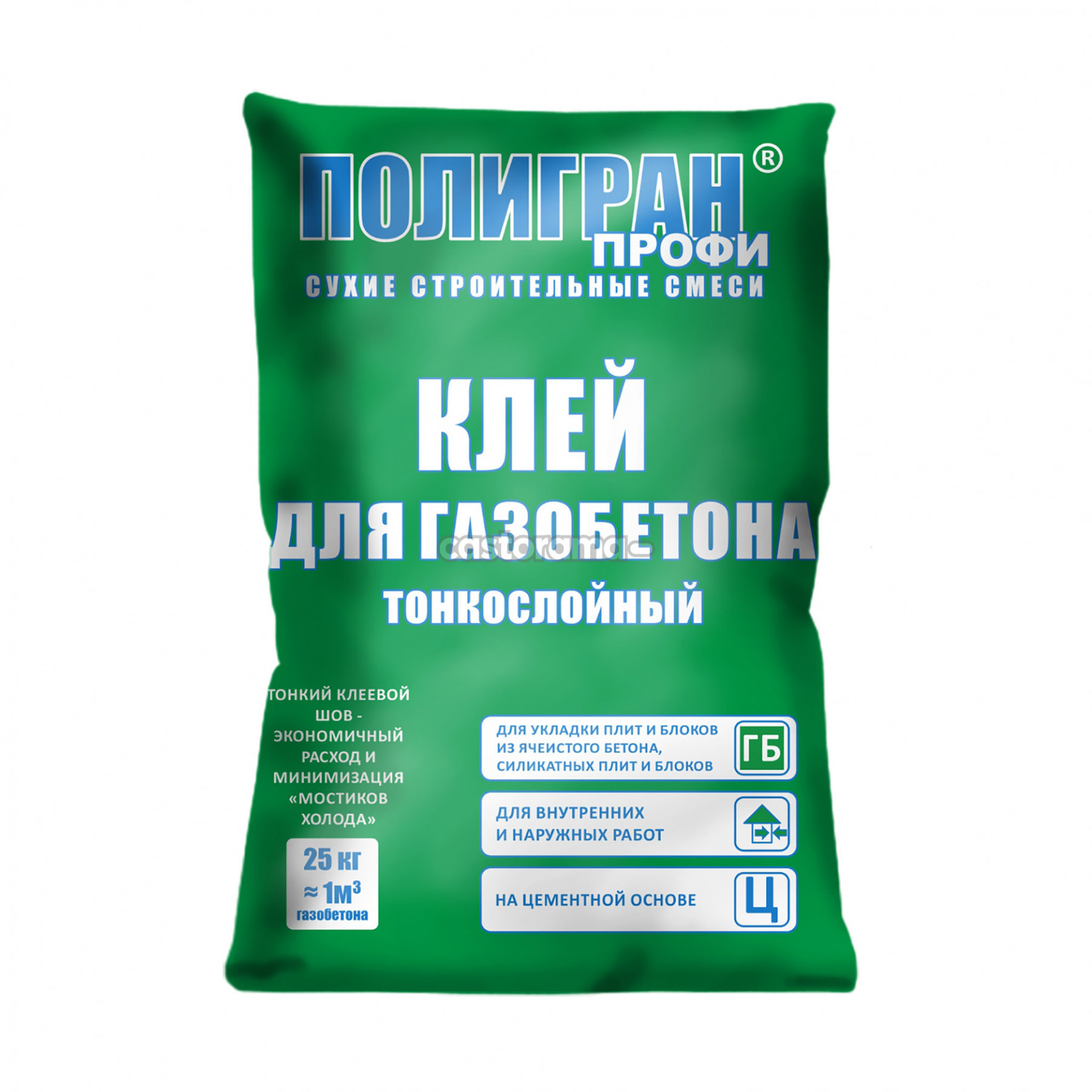
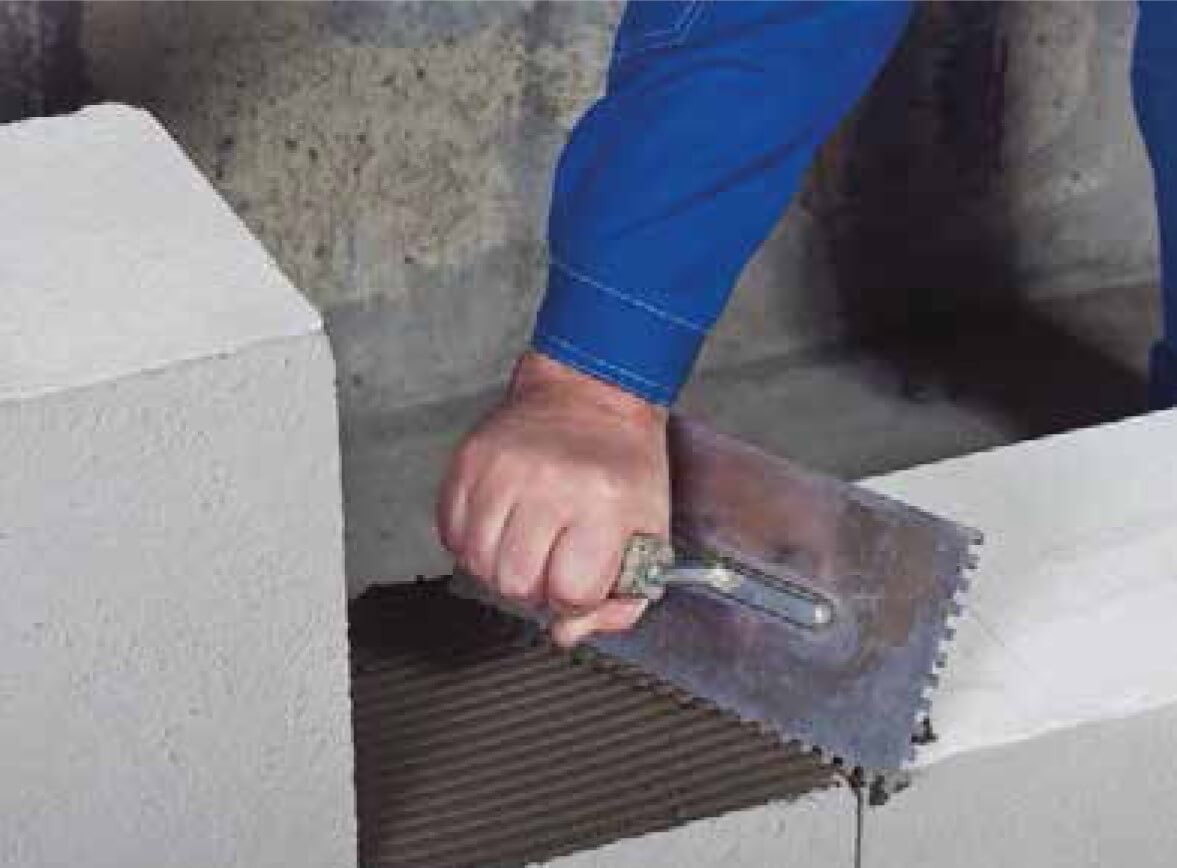
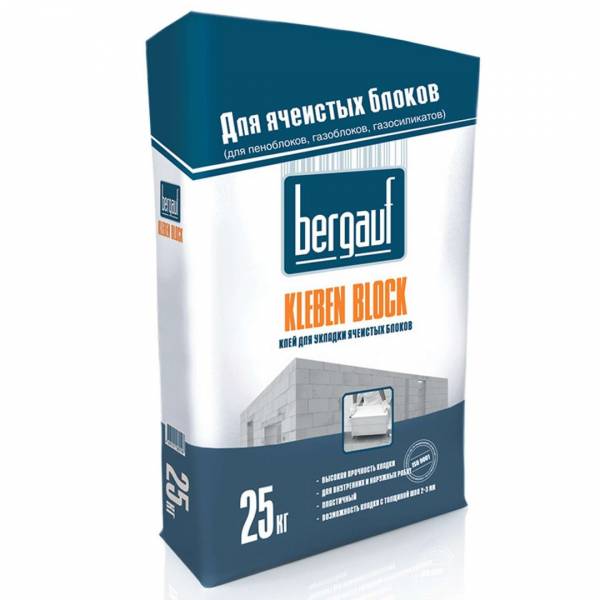
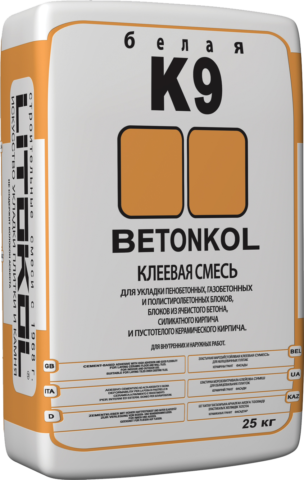 Betonkol adhesive for aerated concrete and polystyrene concrete masonry
Betonkol adhesive for aerated concrete and polystyrene concrete masonry Bolars lightweight concrete block adhesive
Bolars lightweight concrete block adhesive Glue "block"
Glue "block"